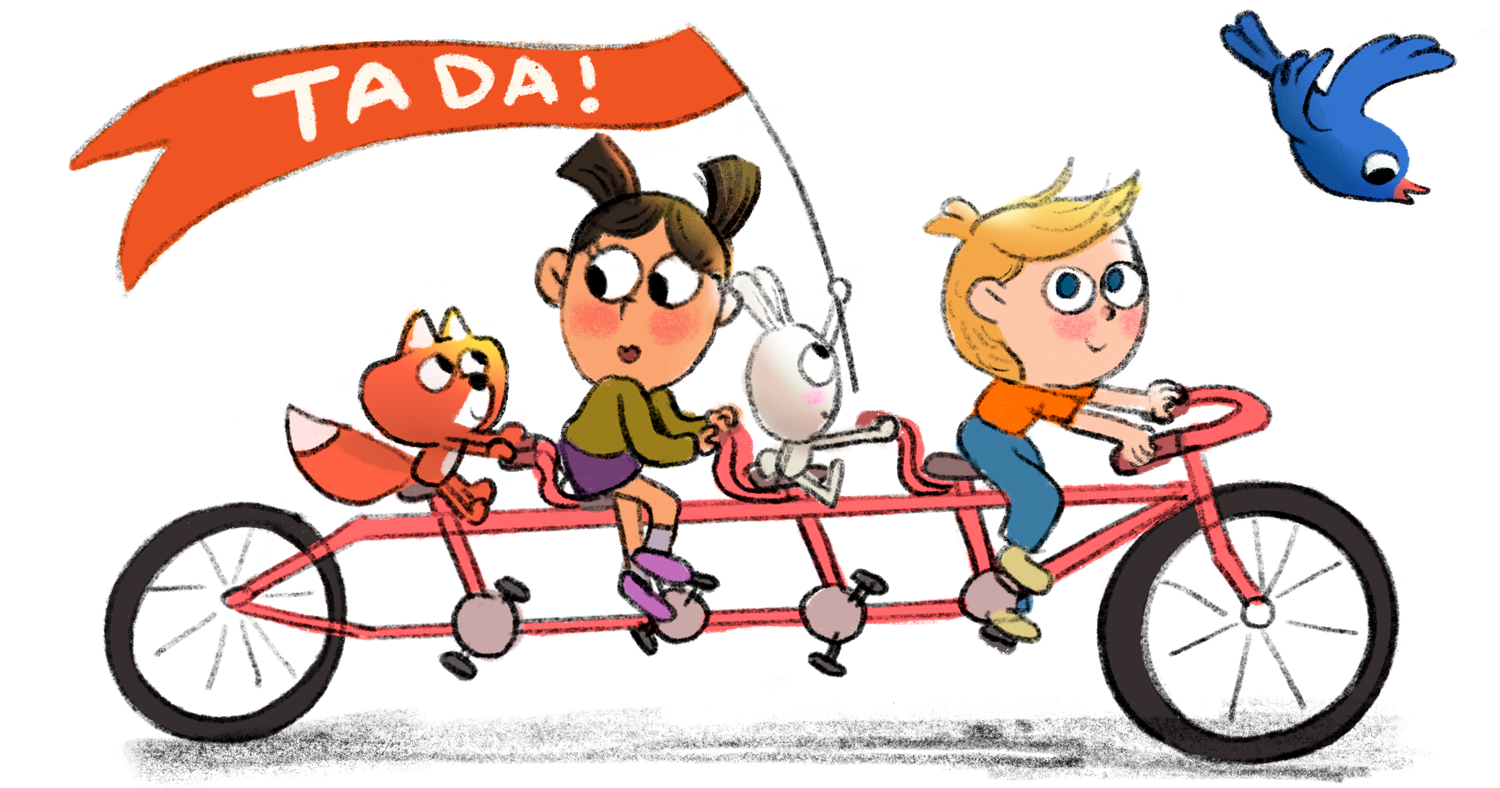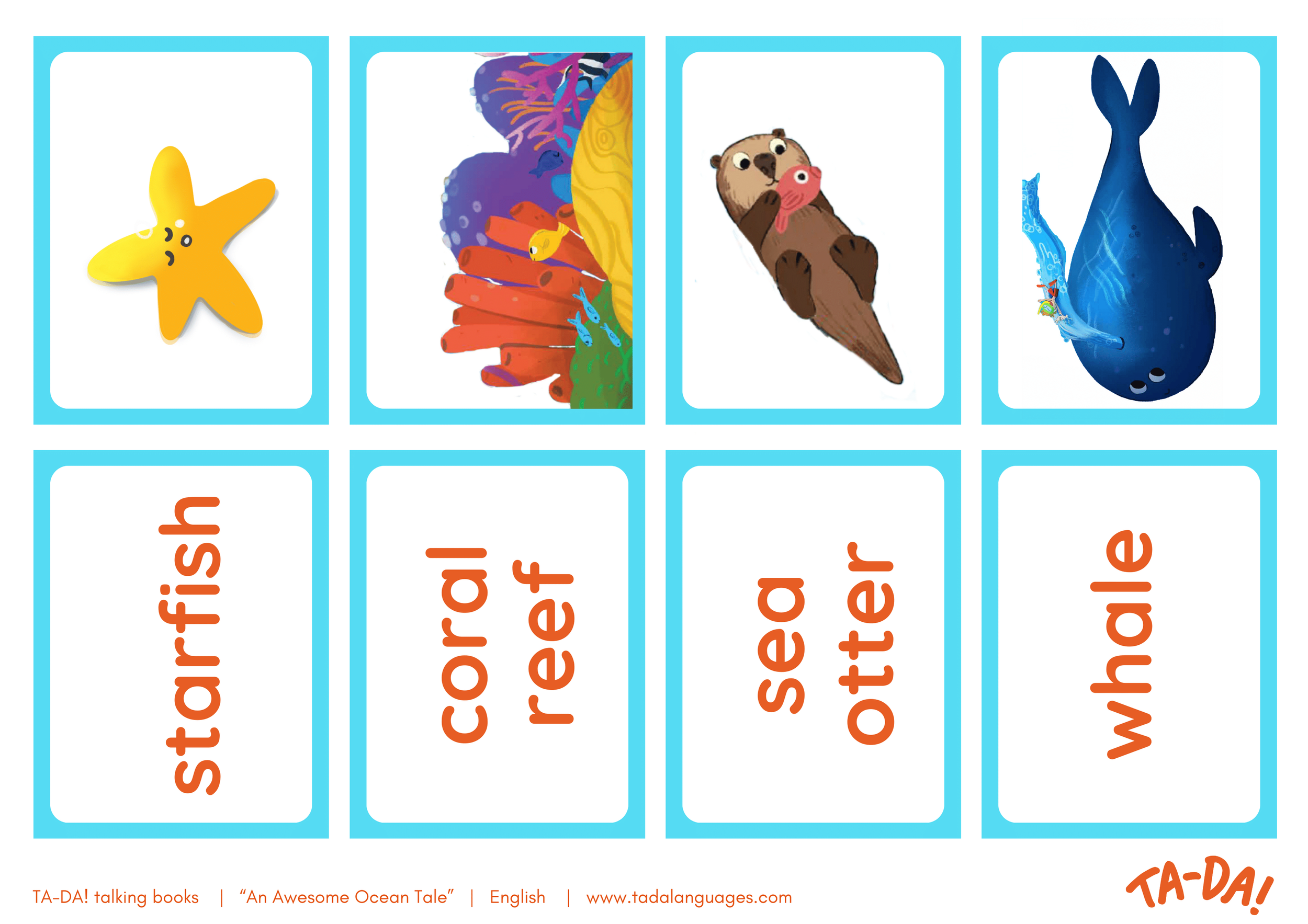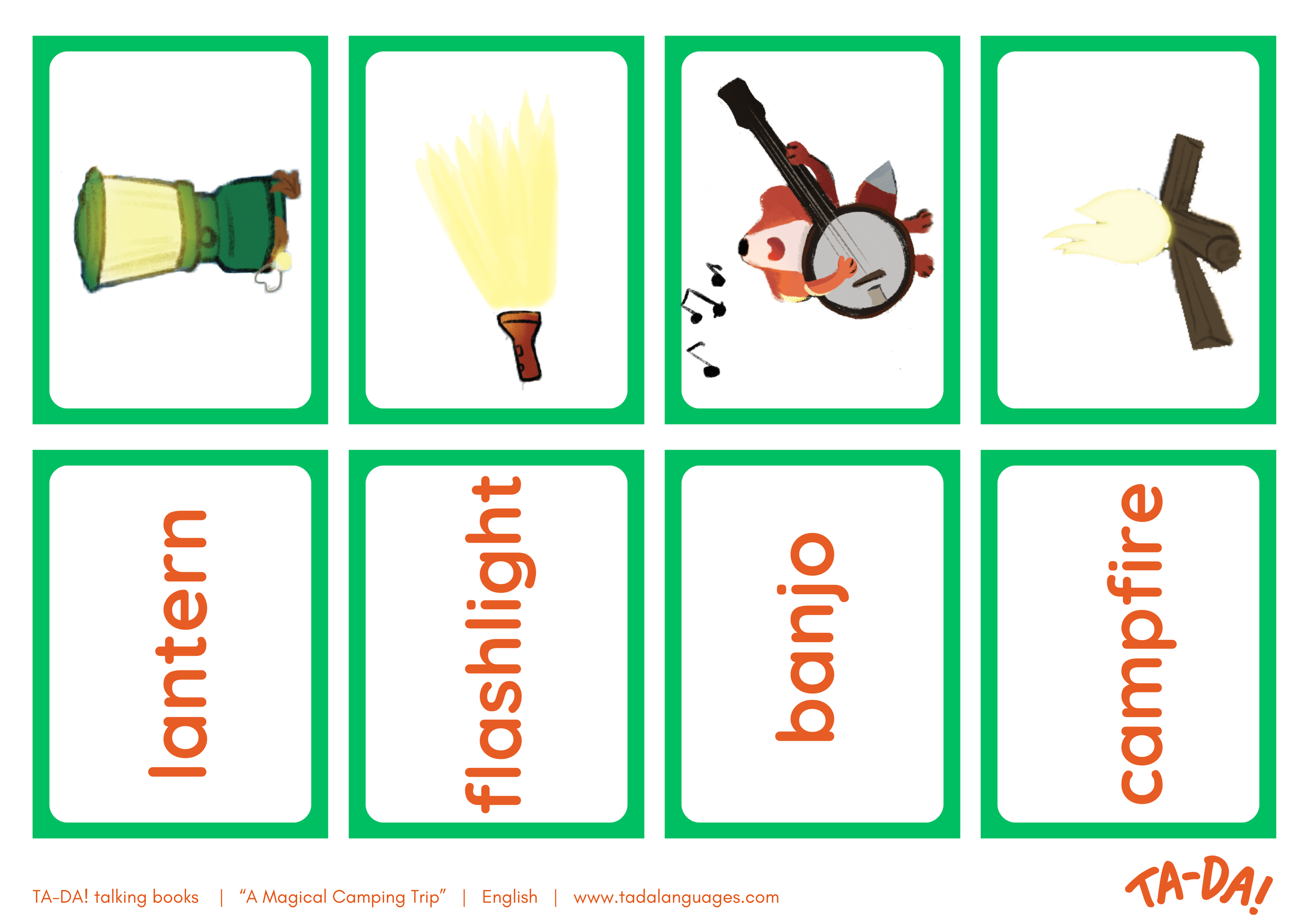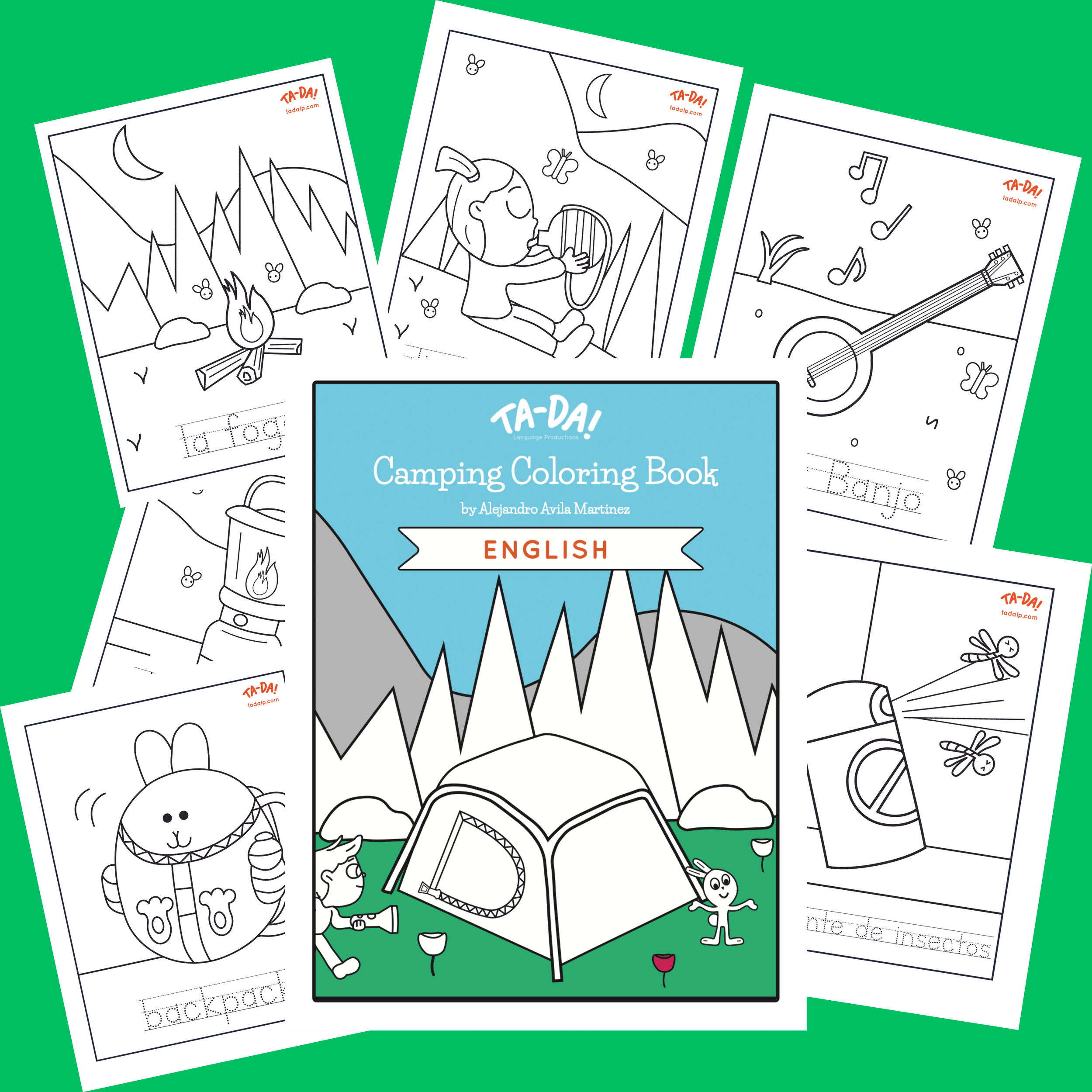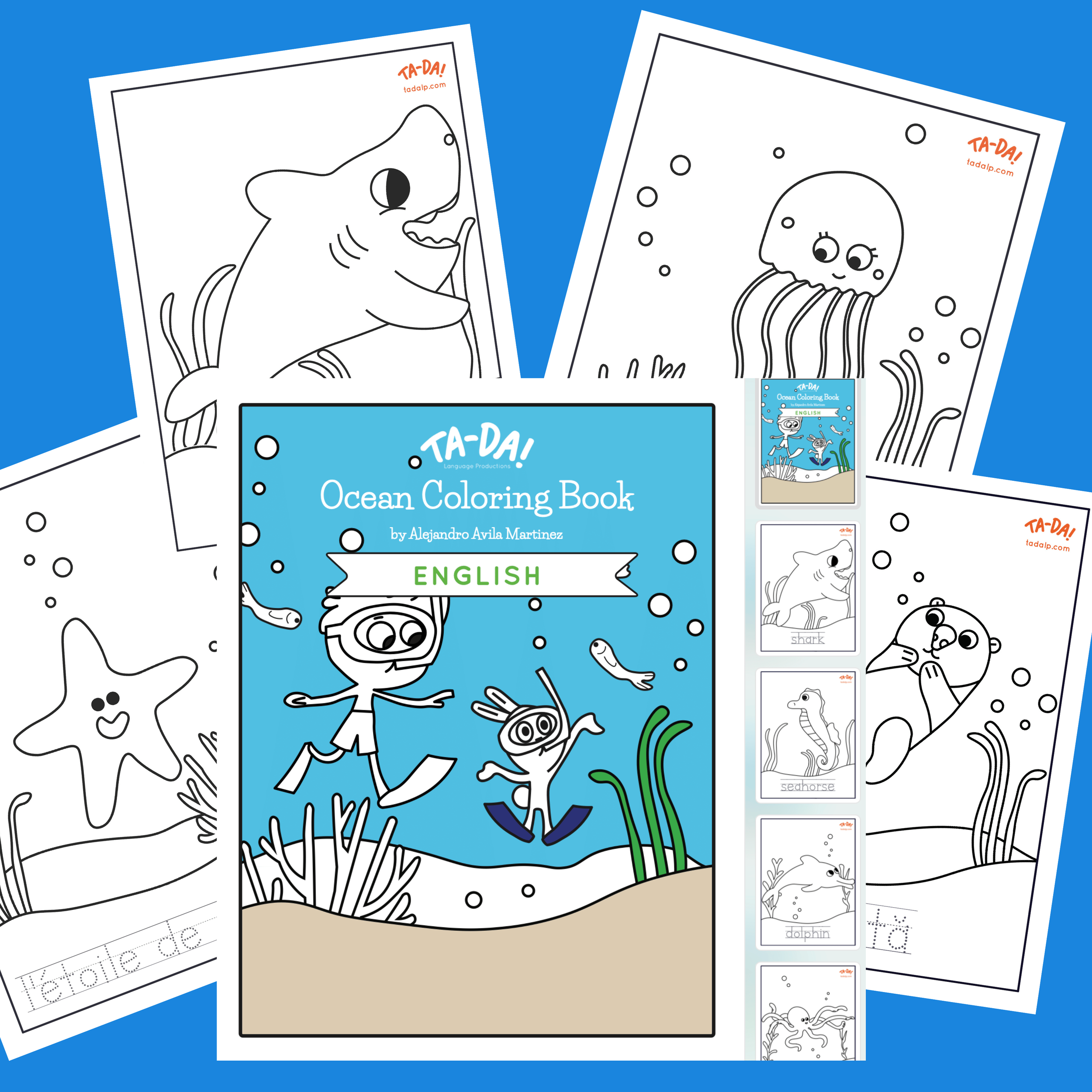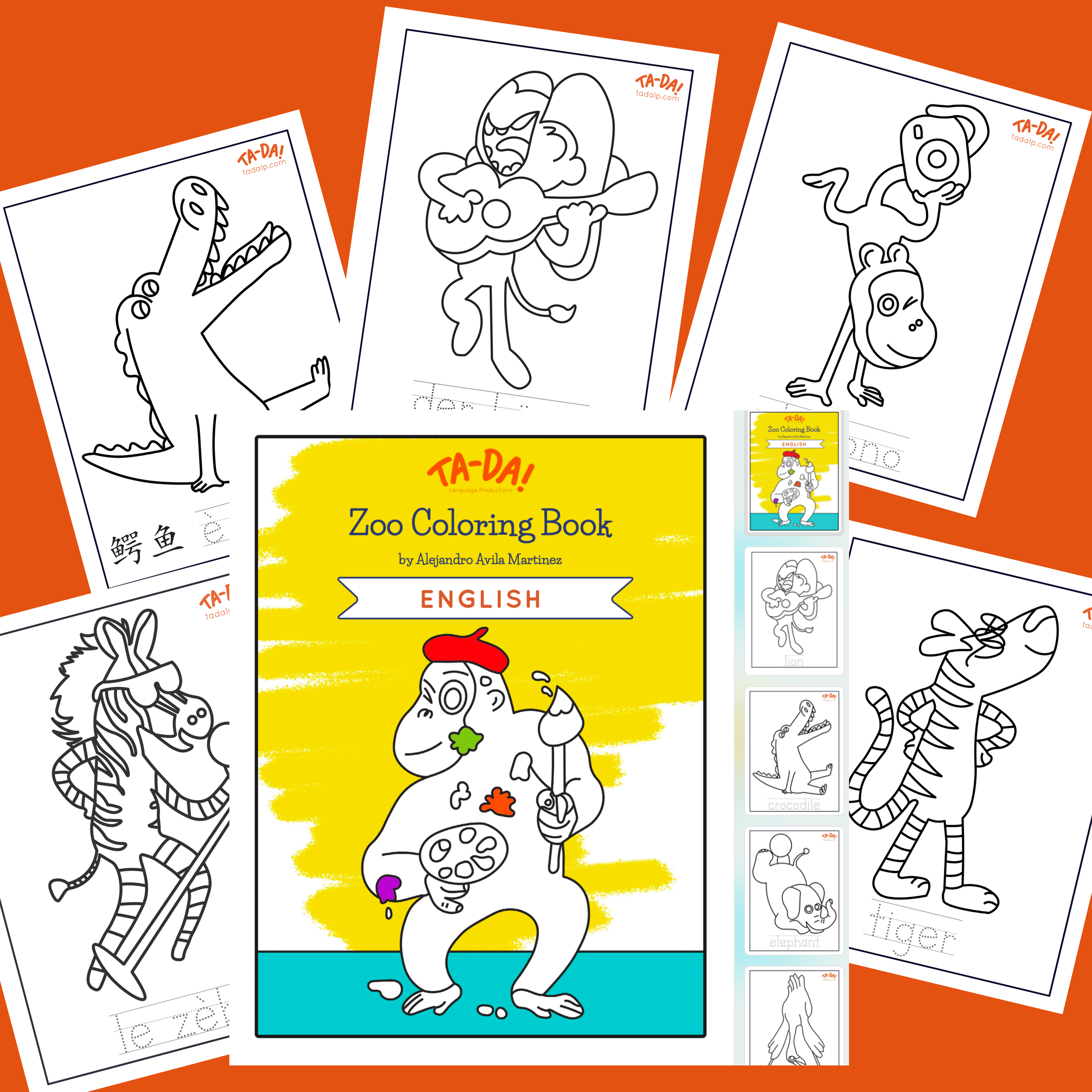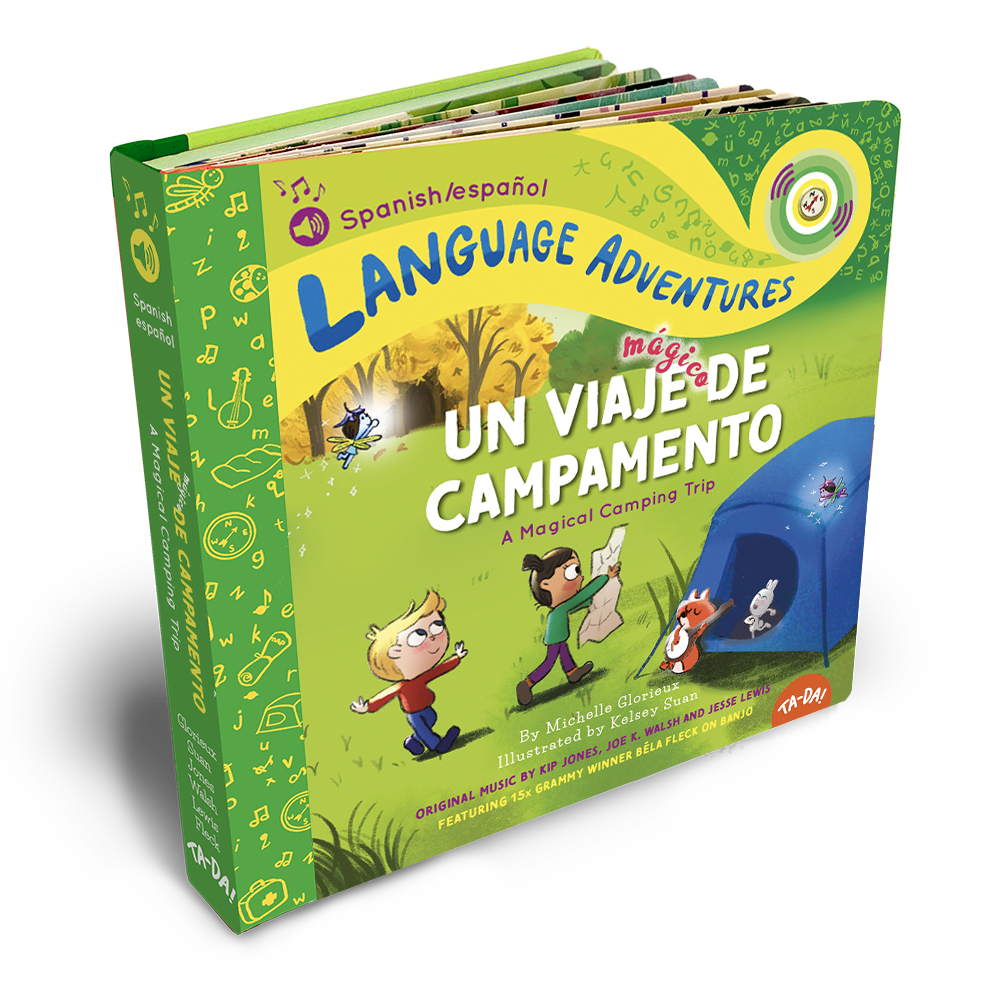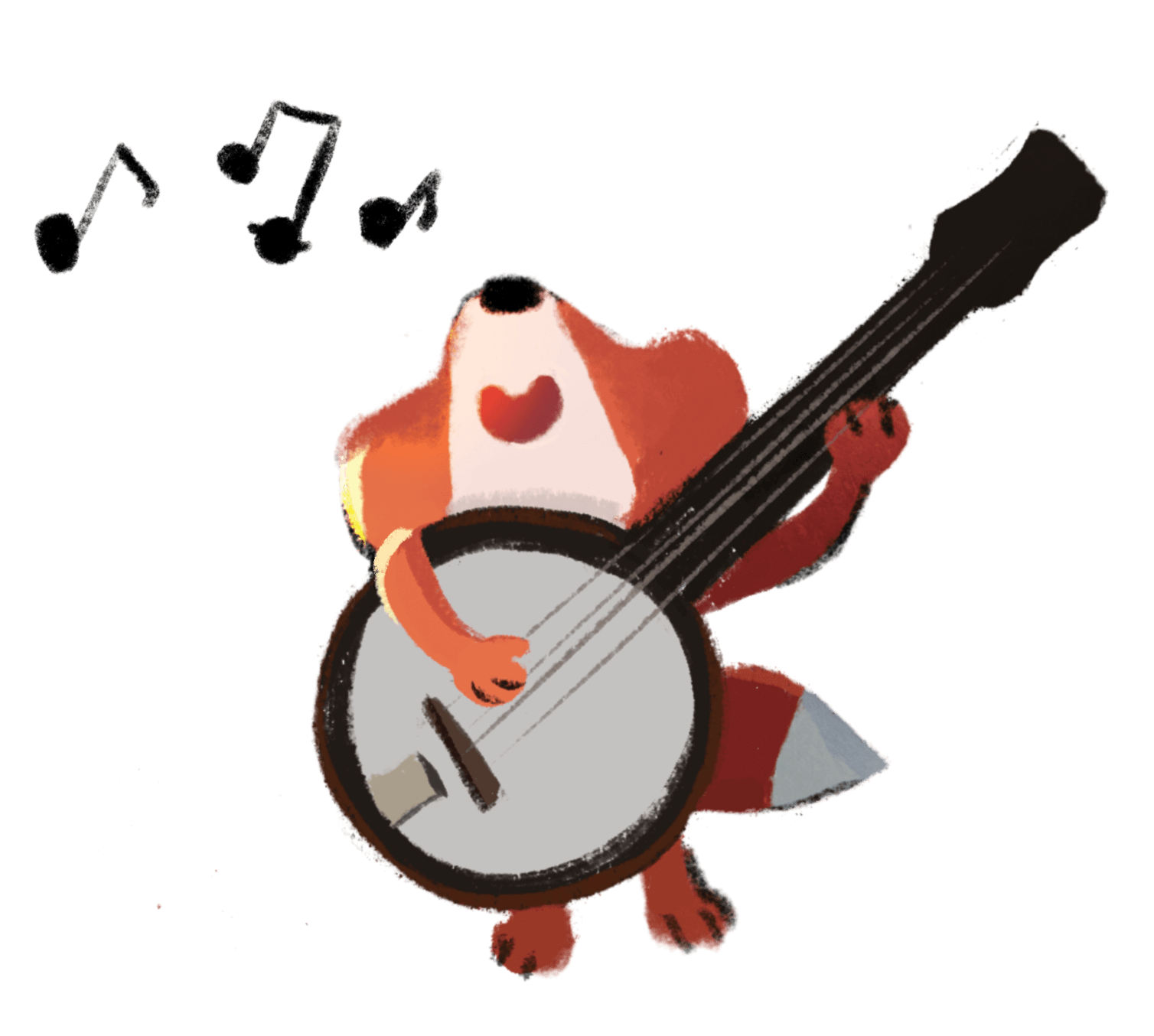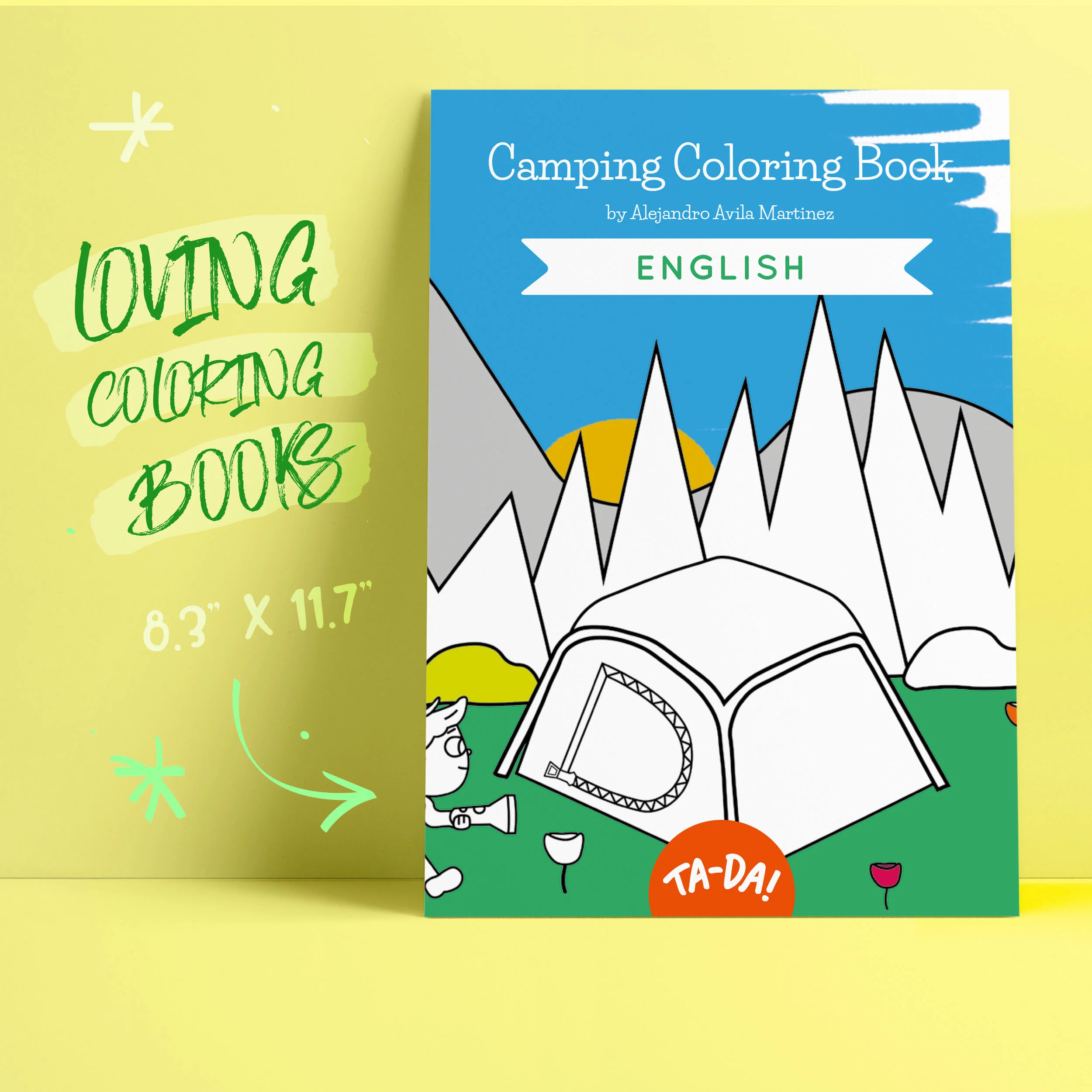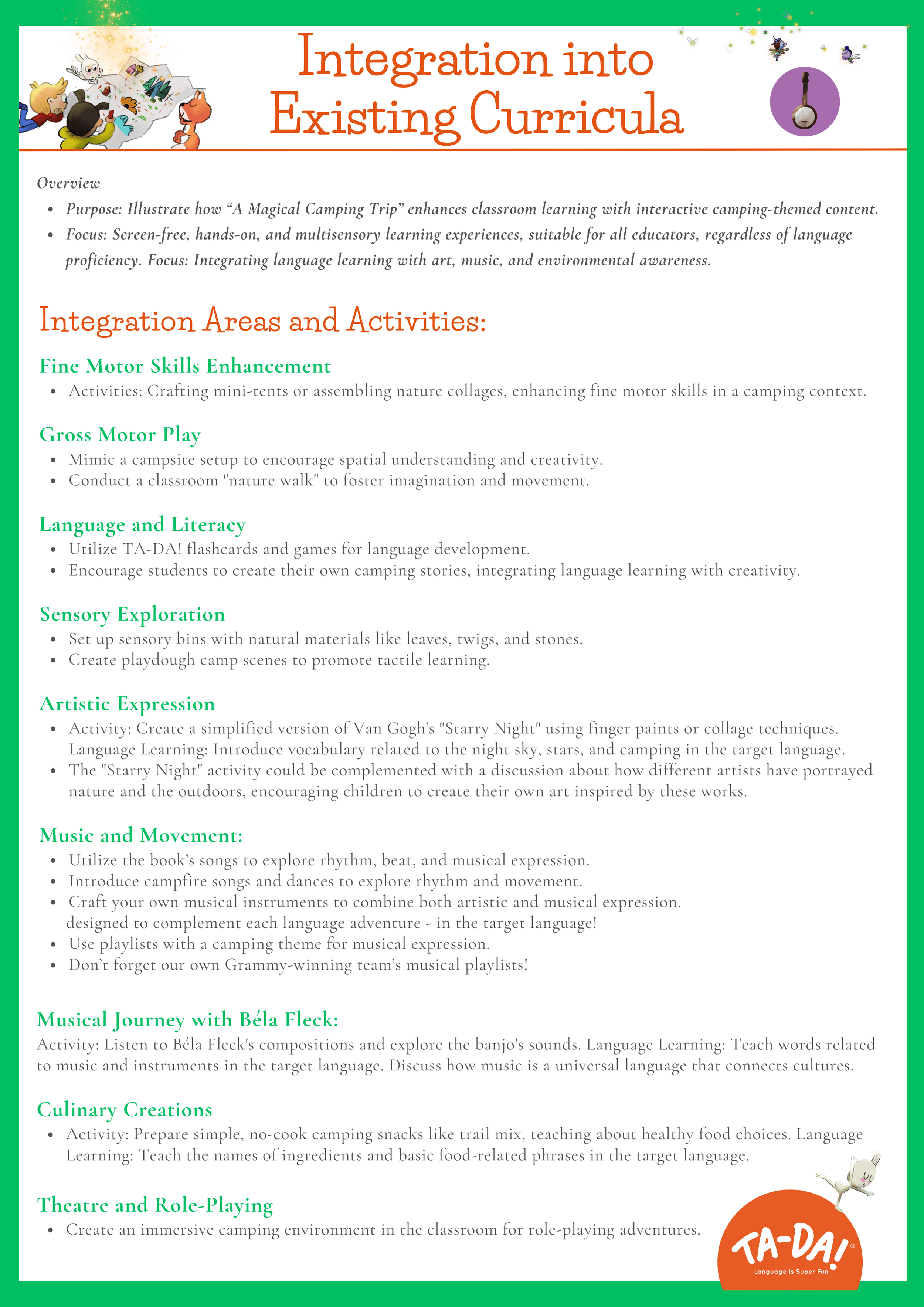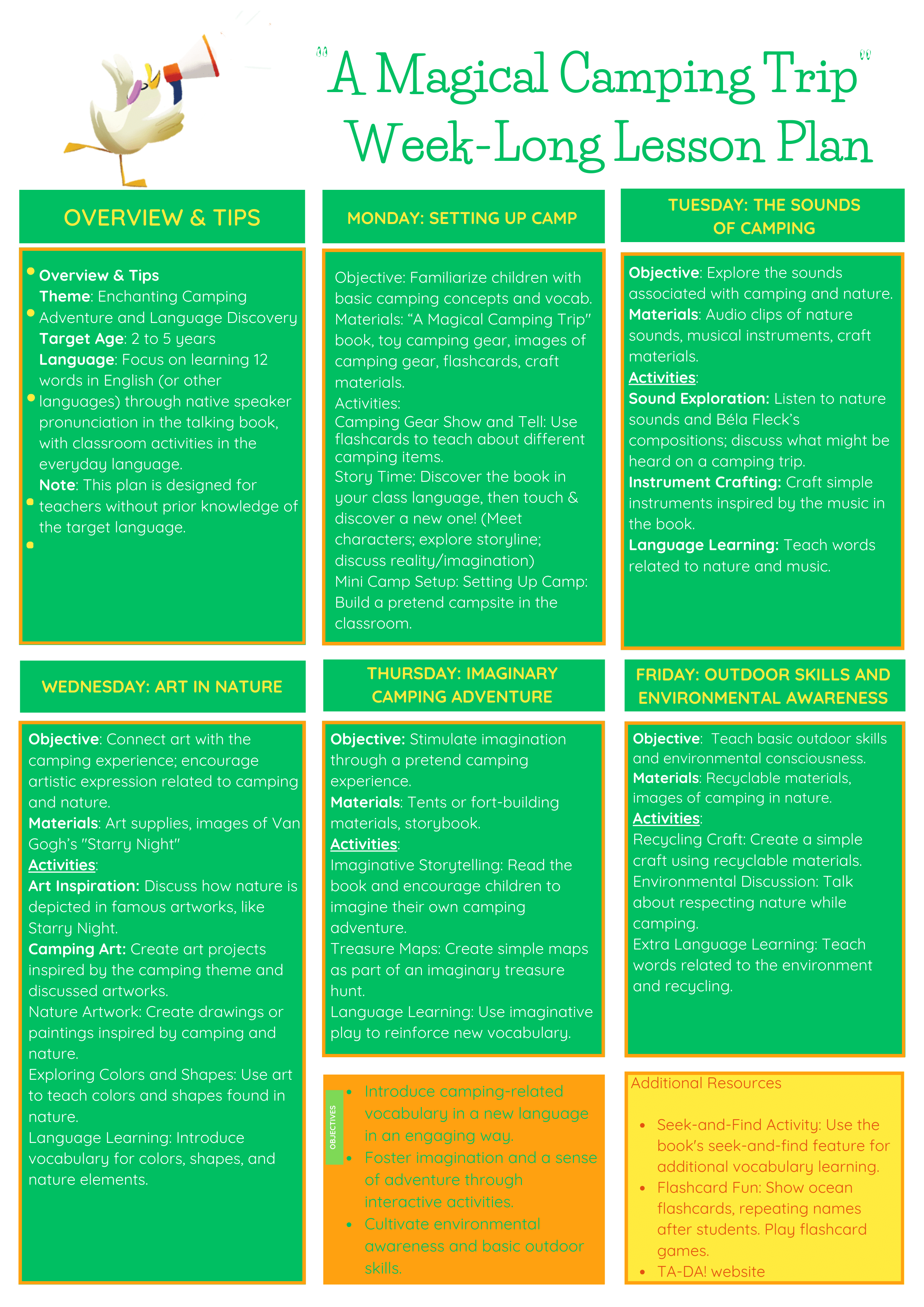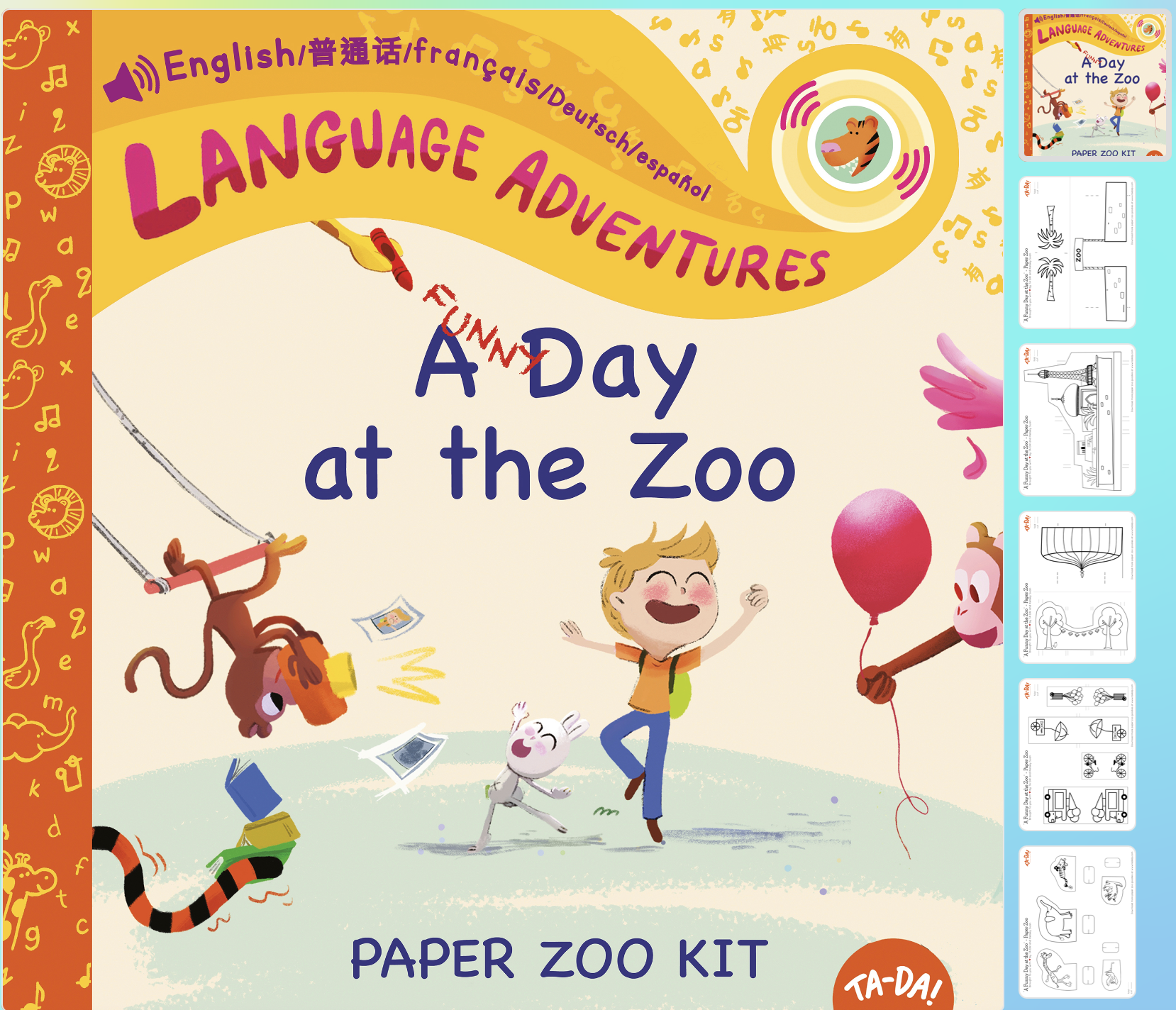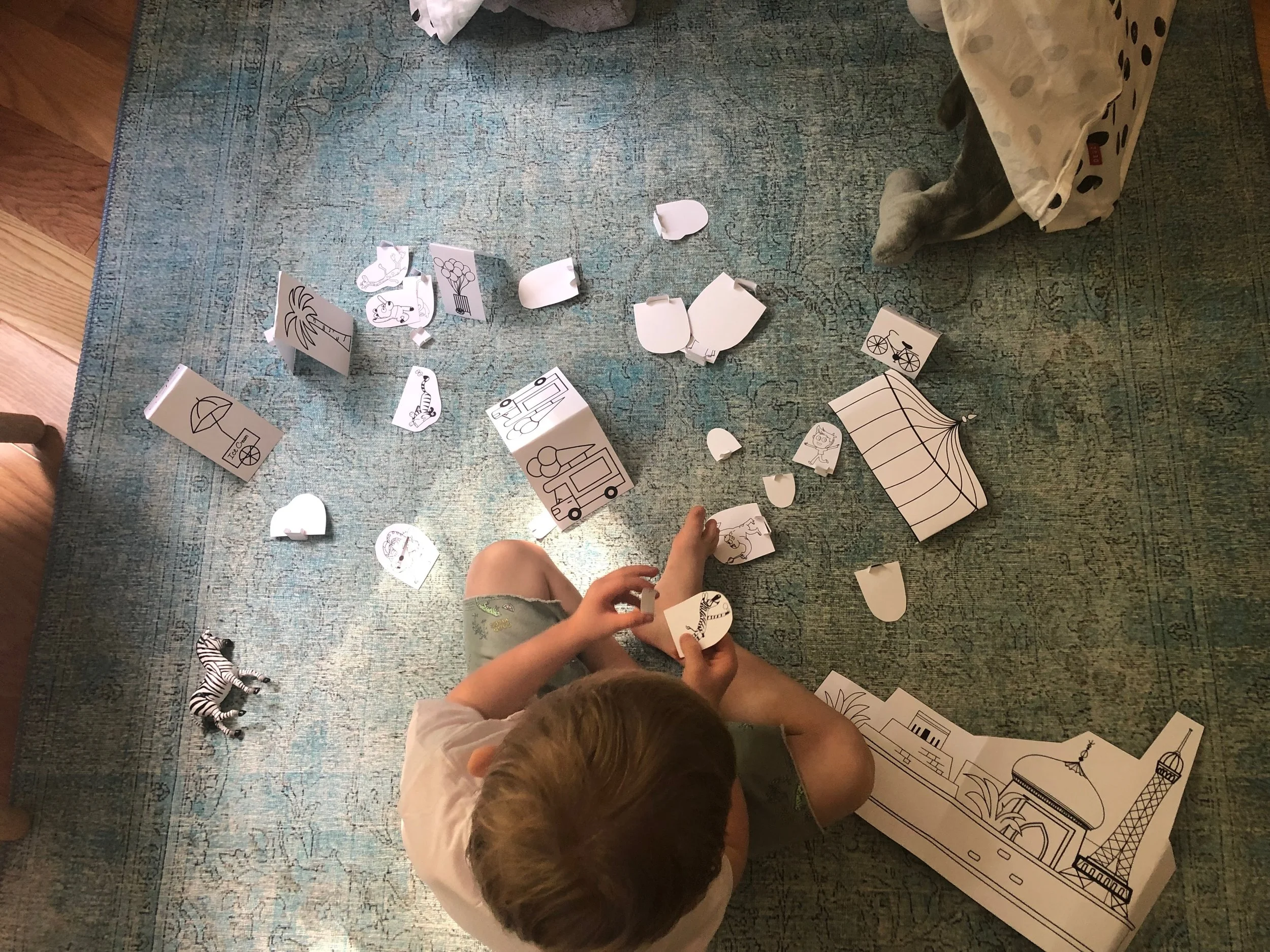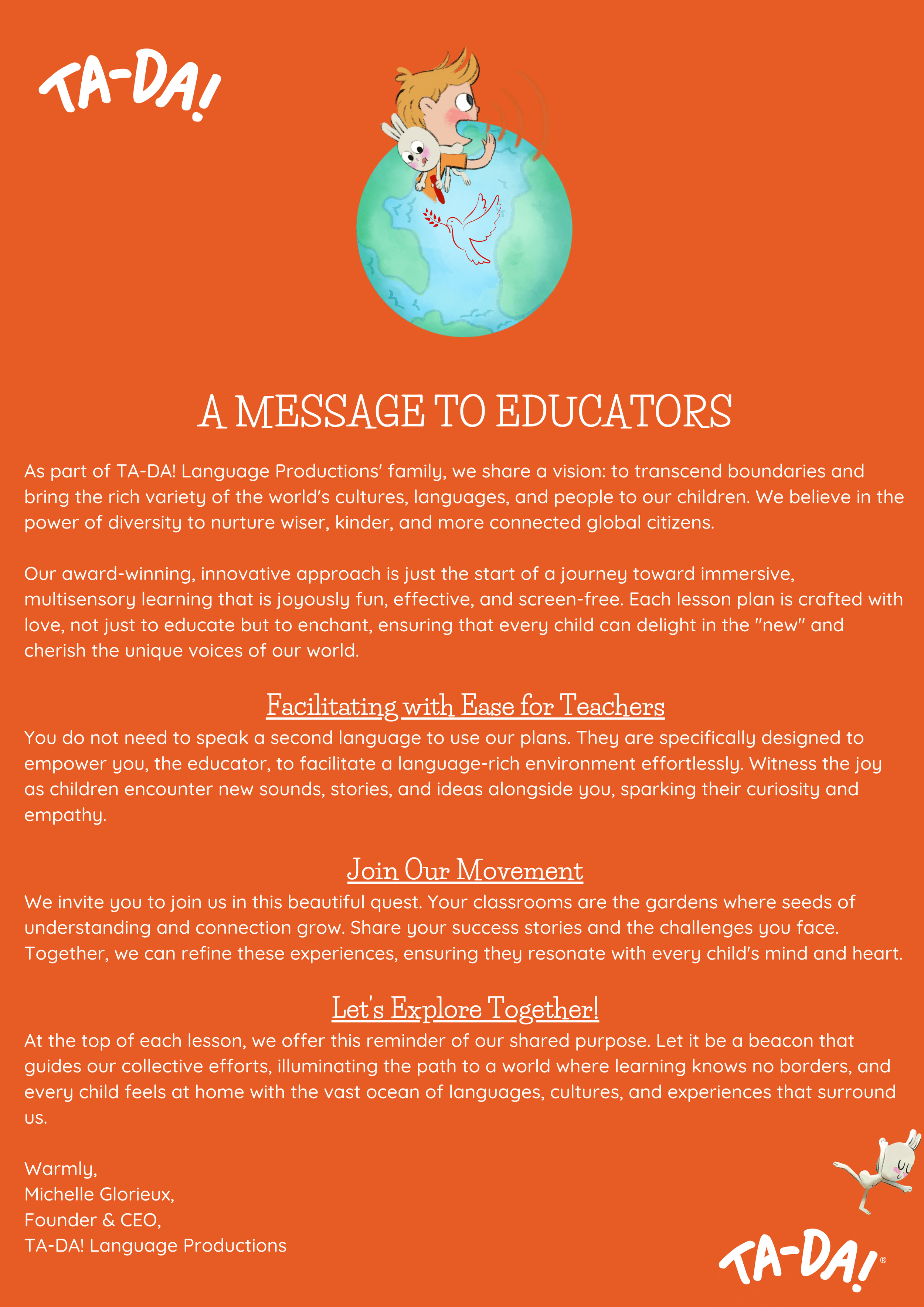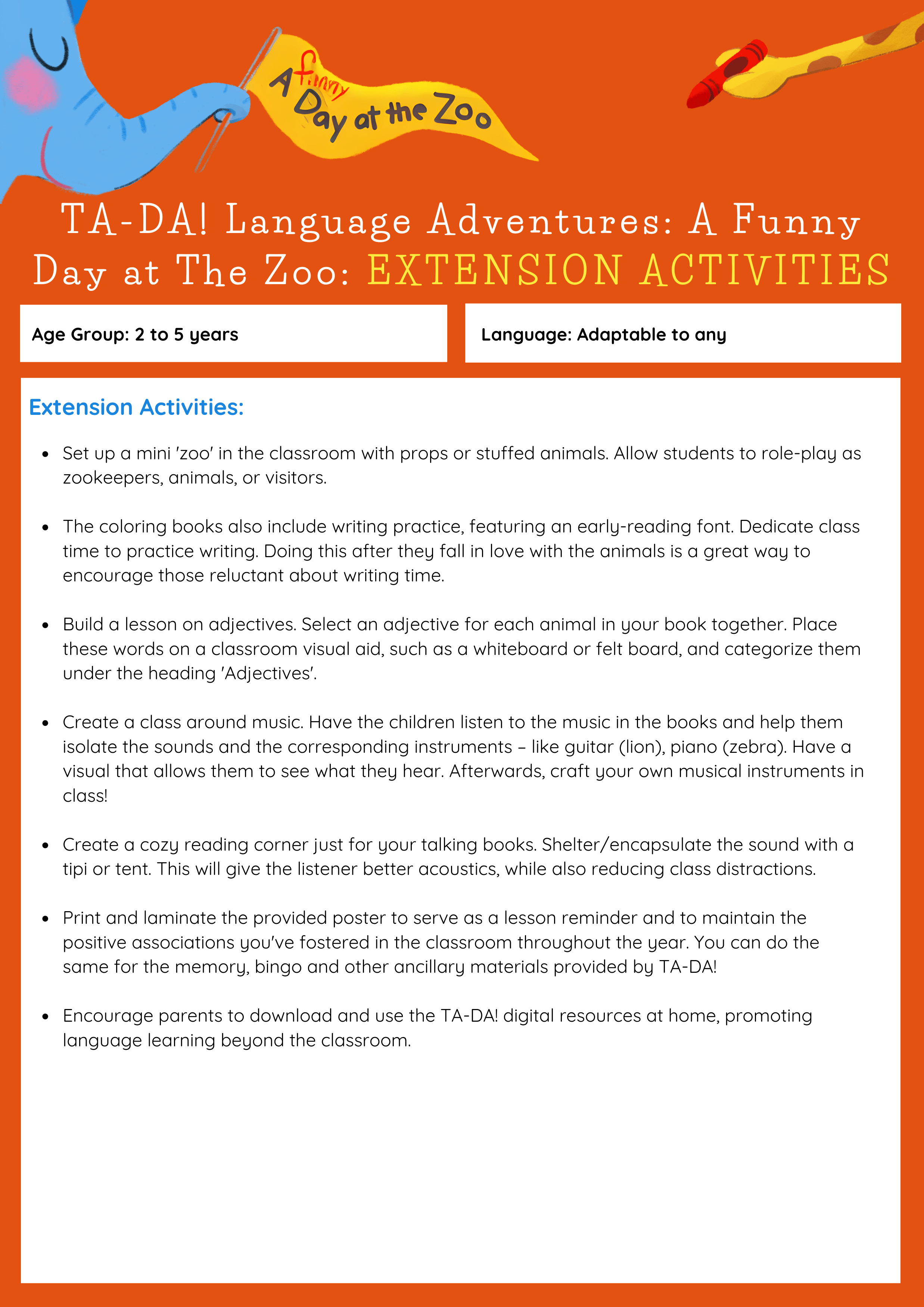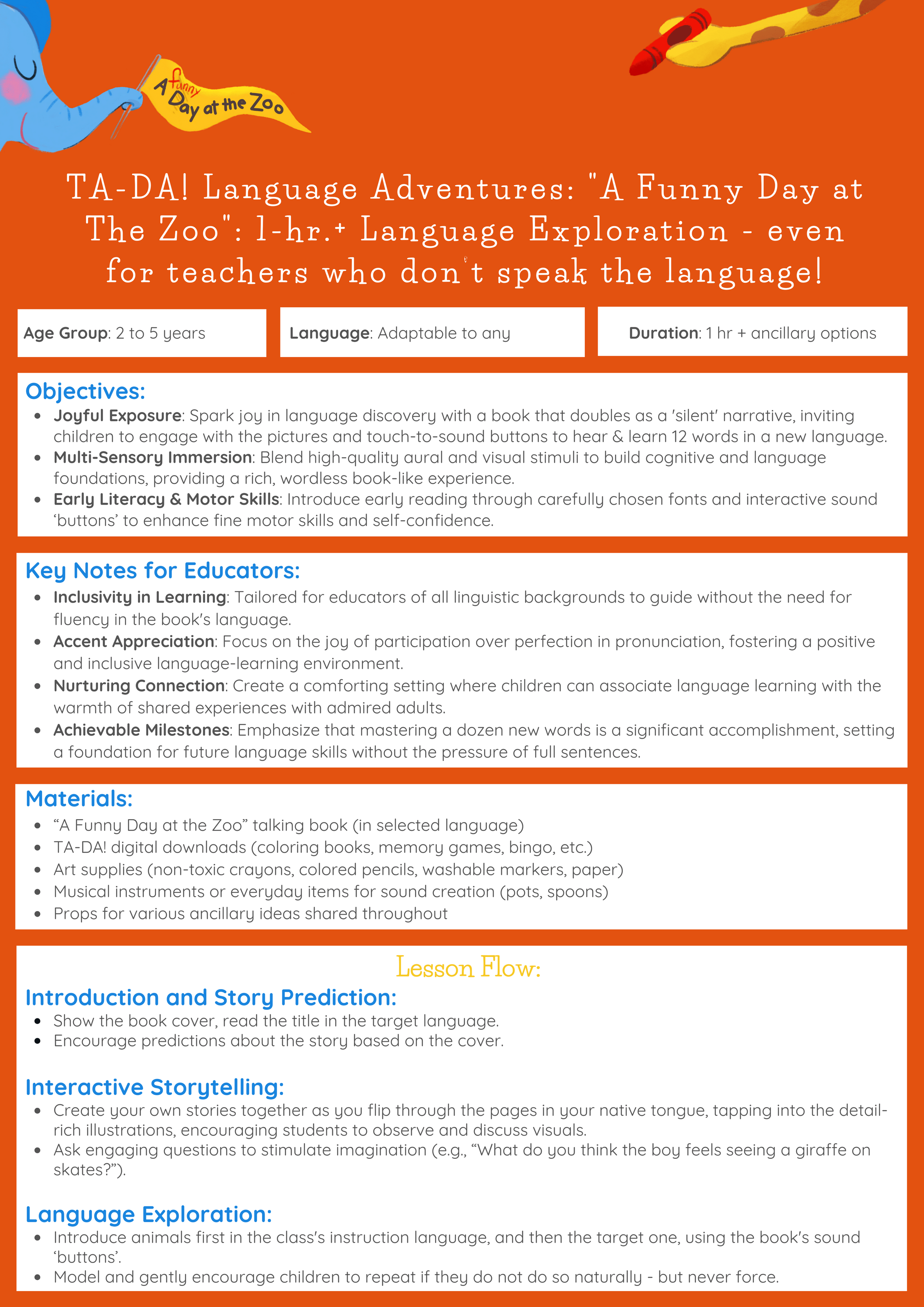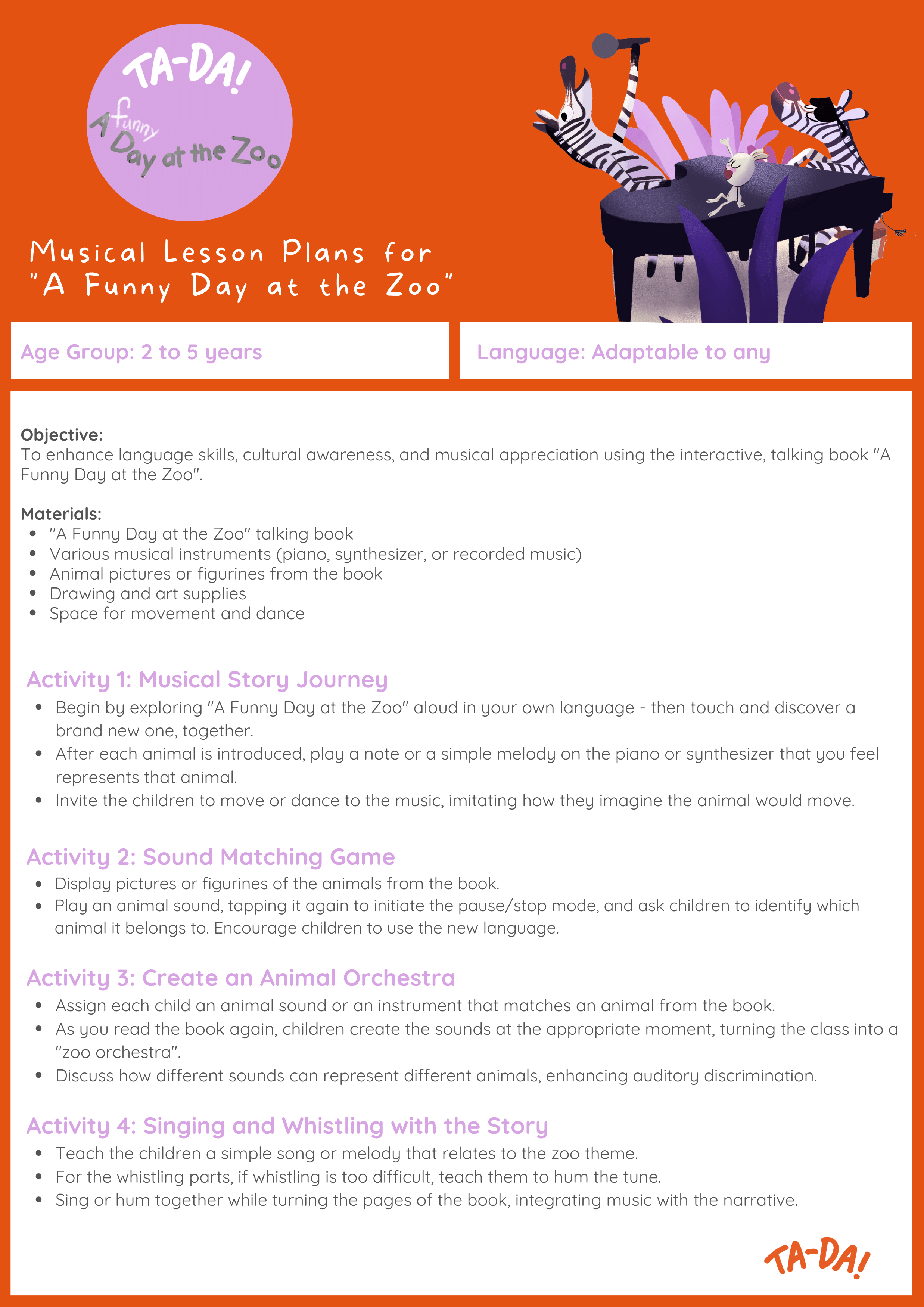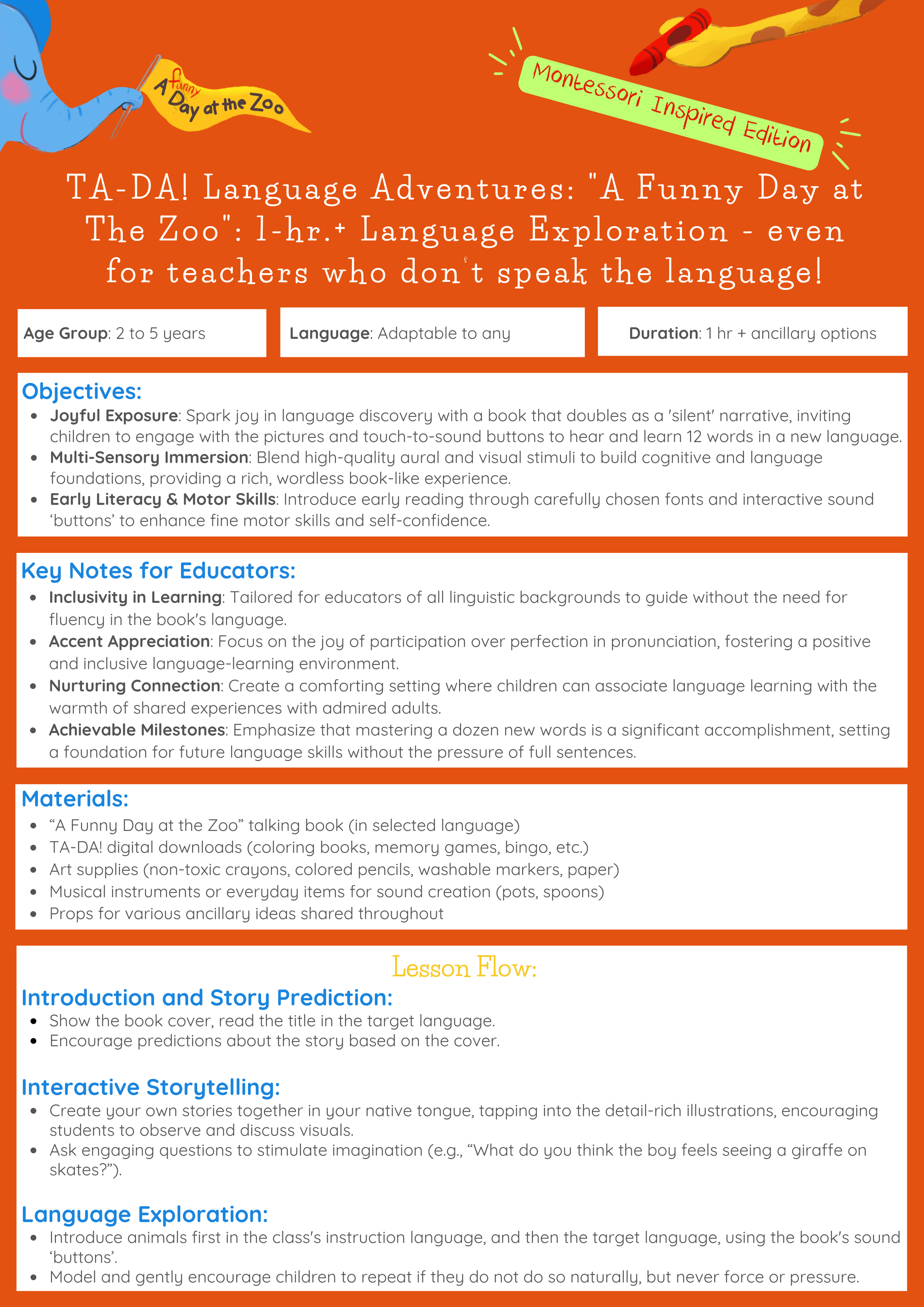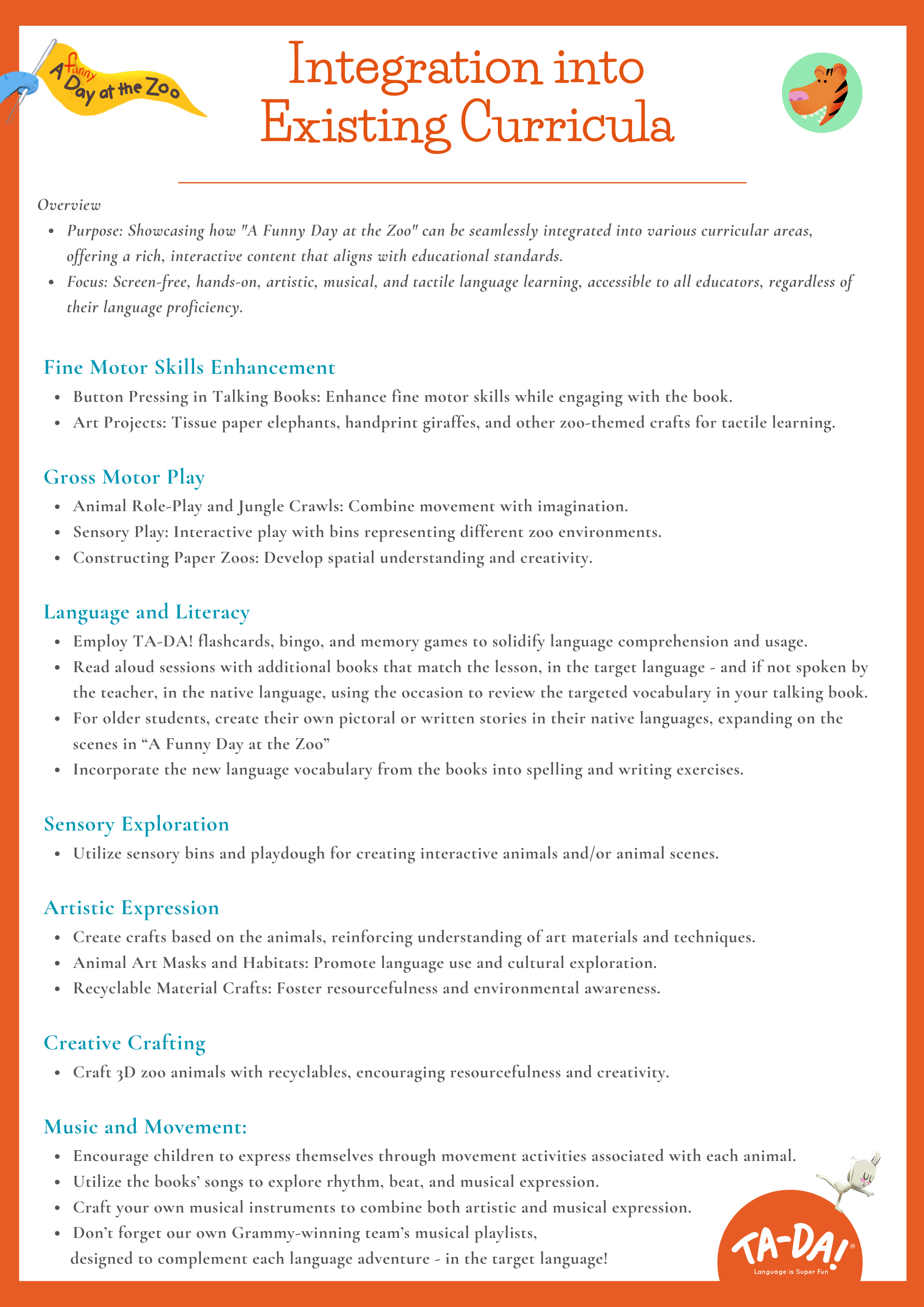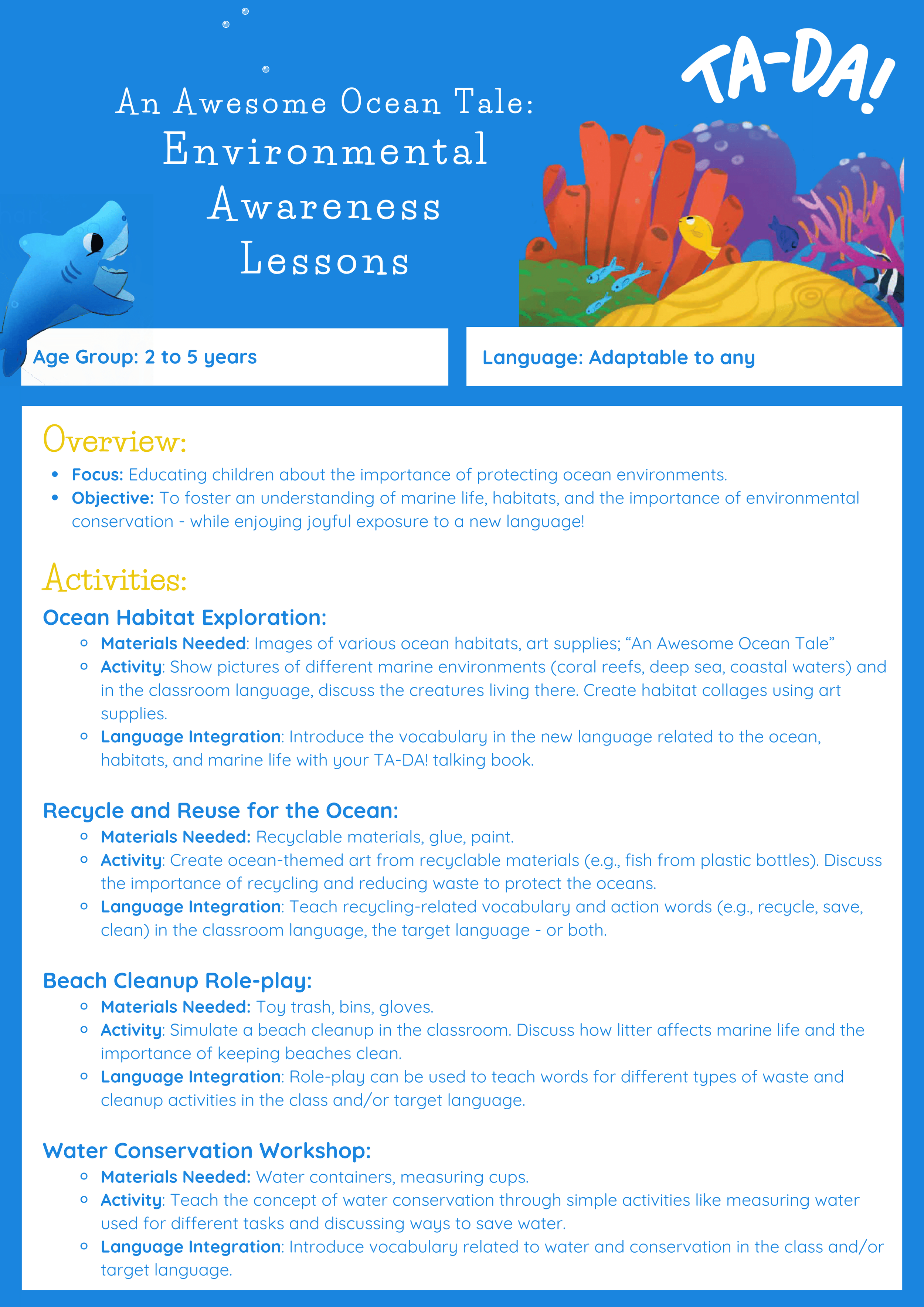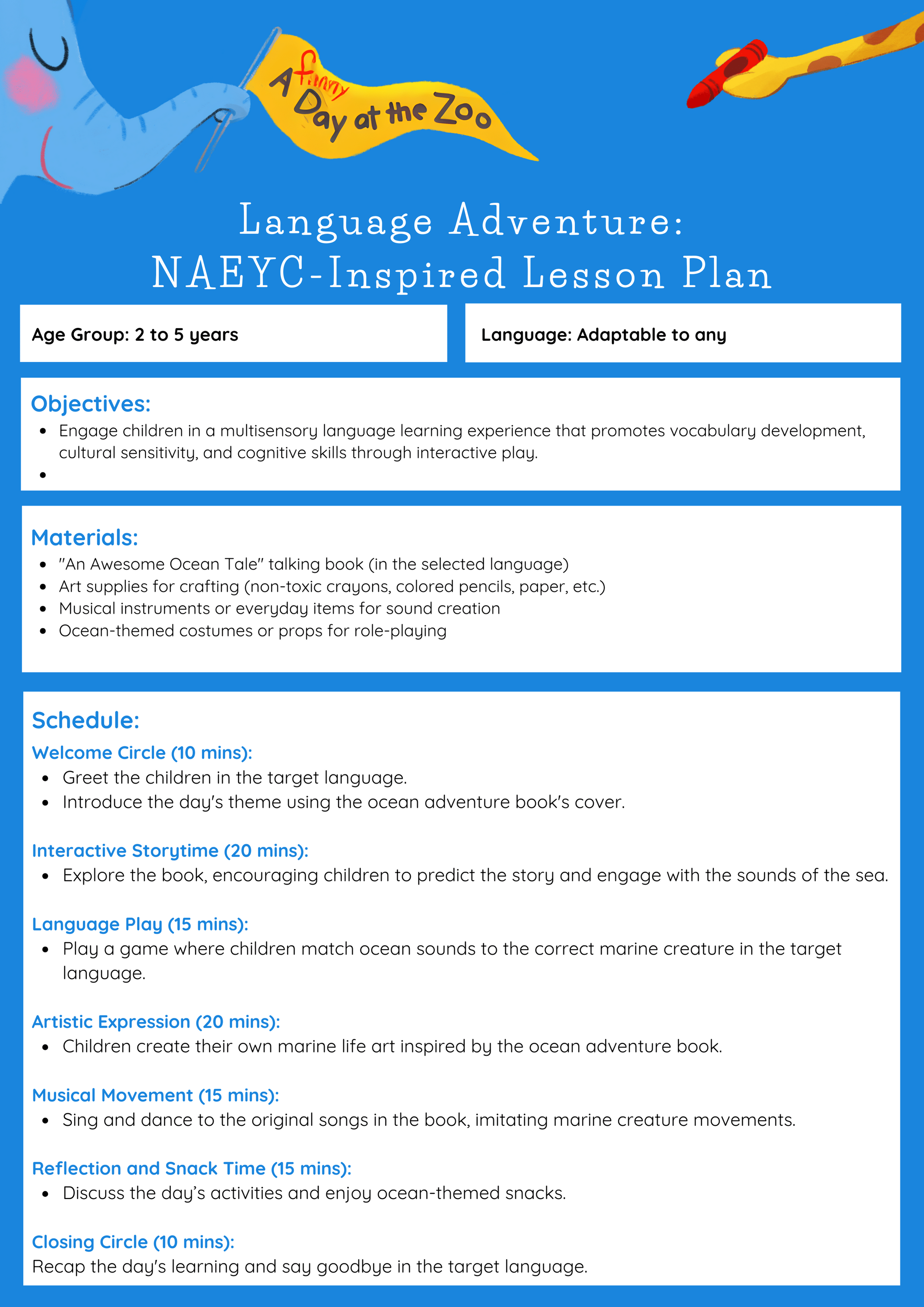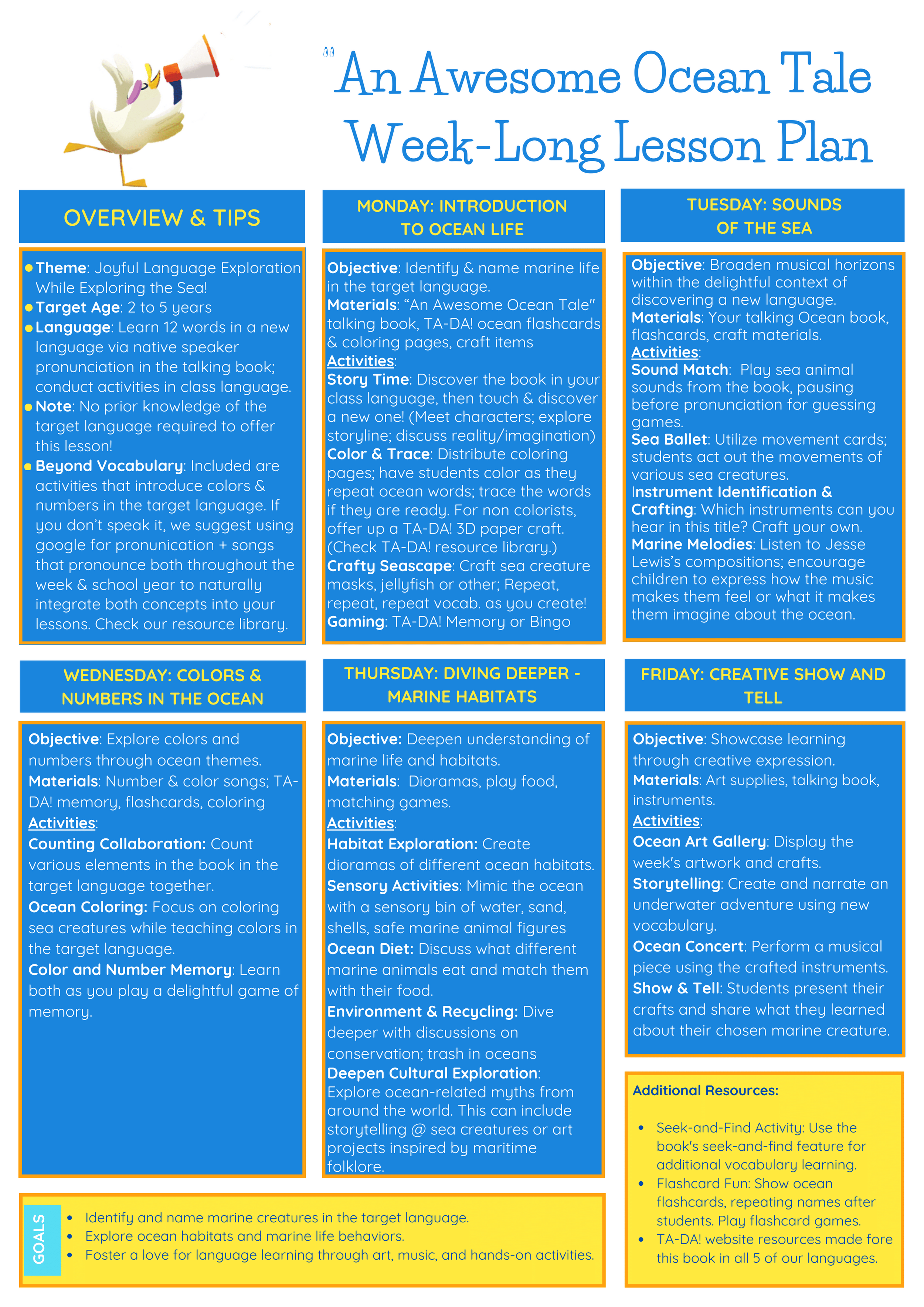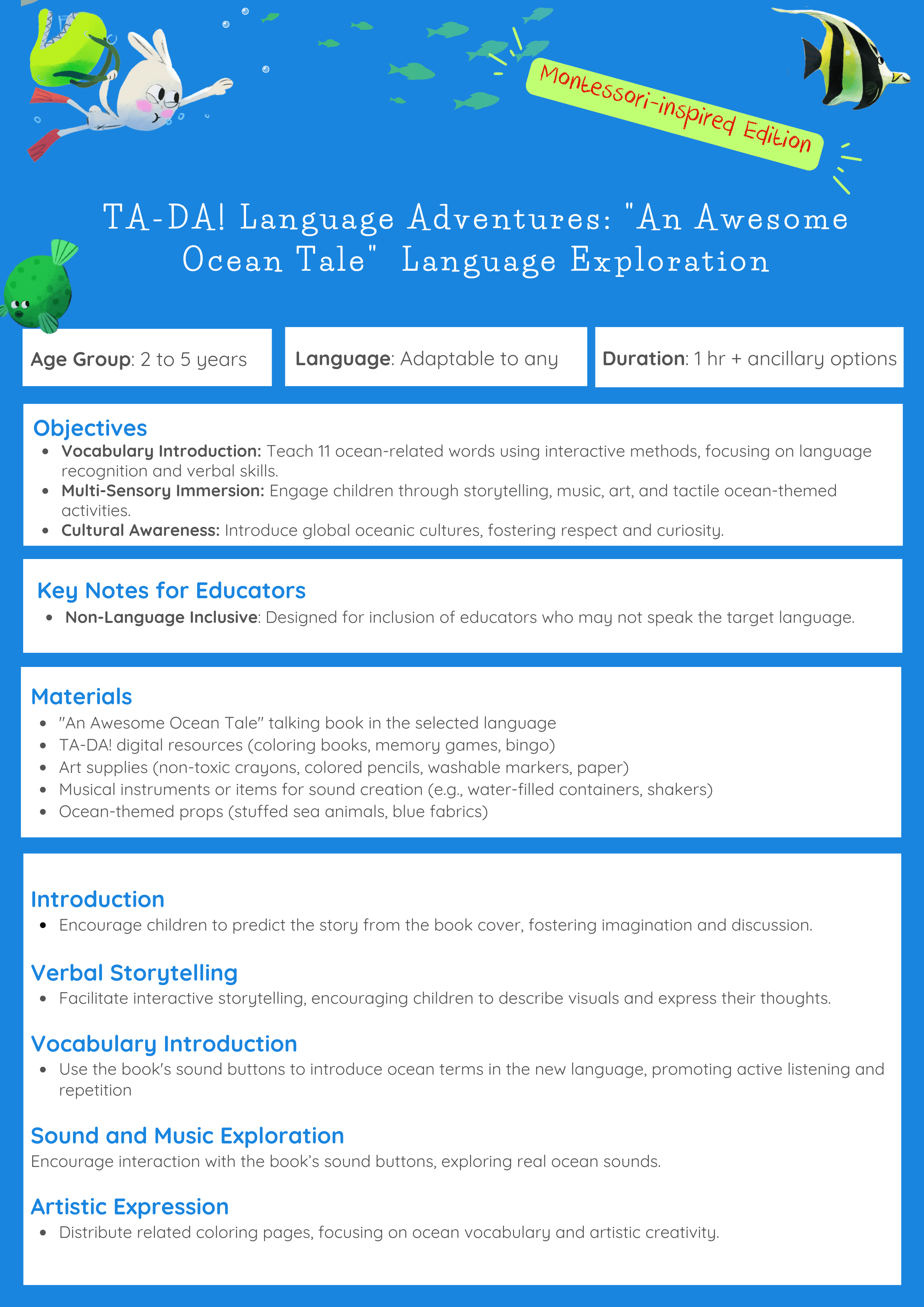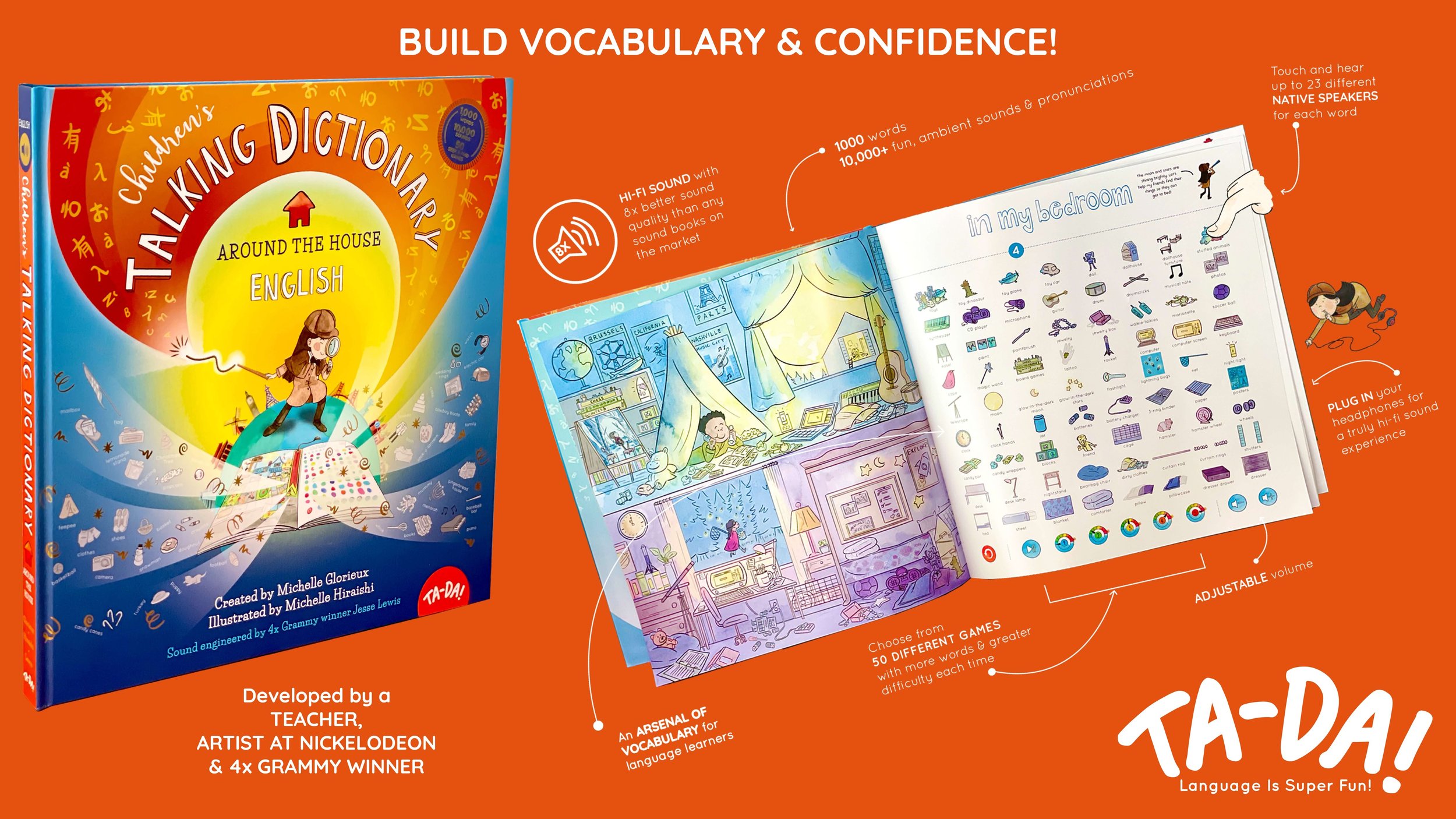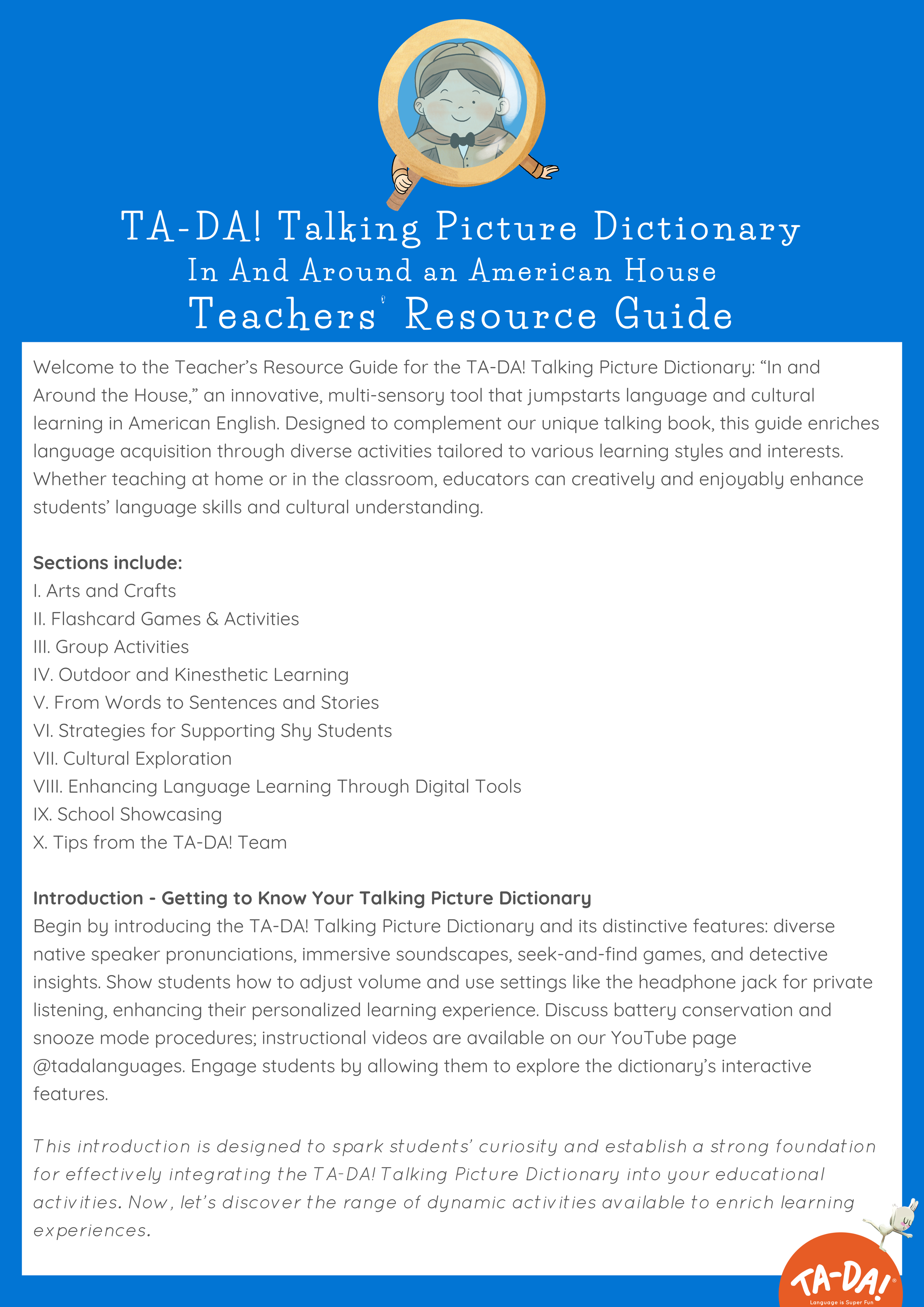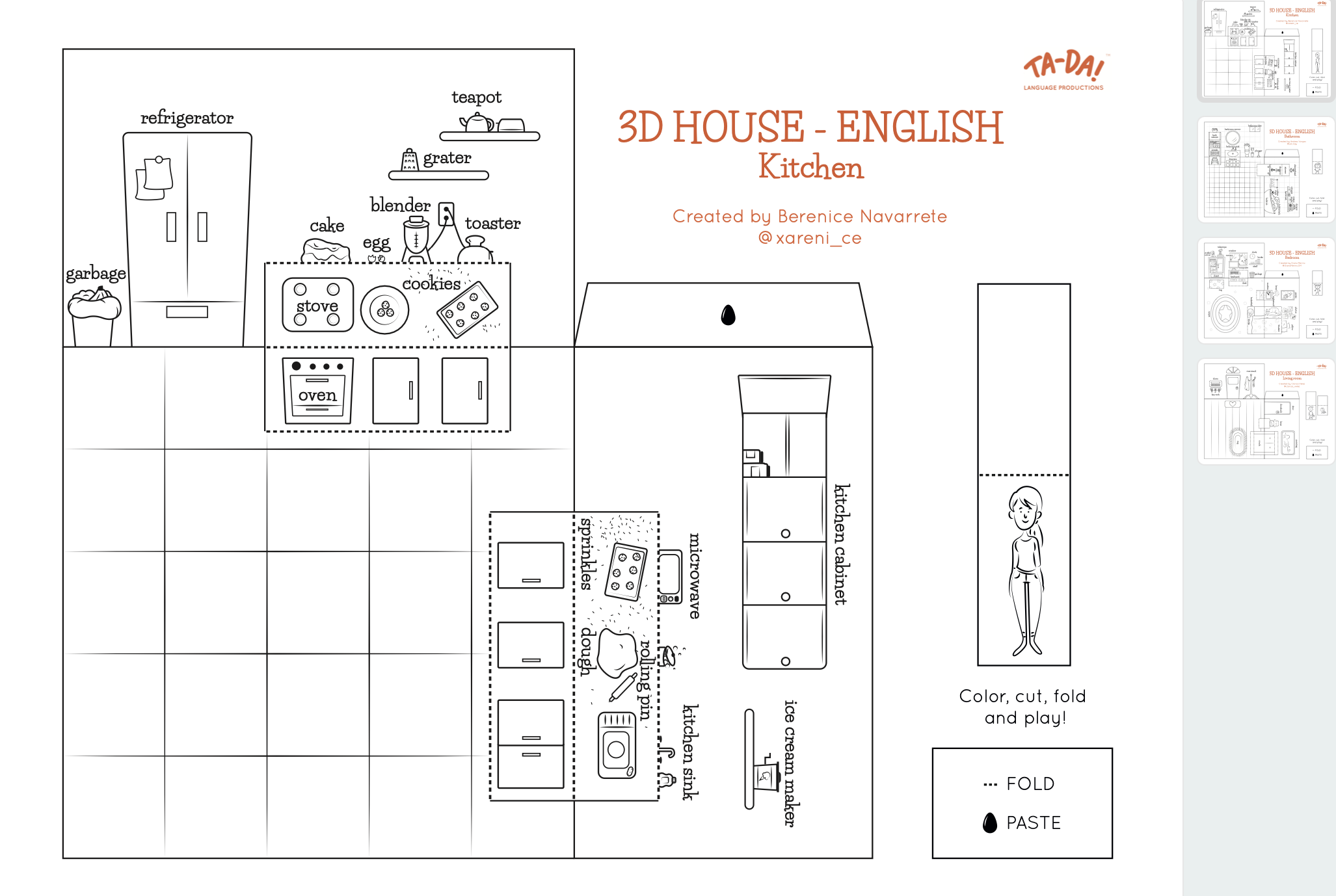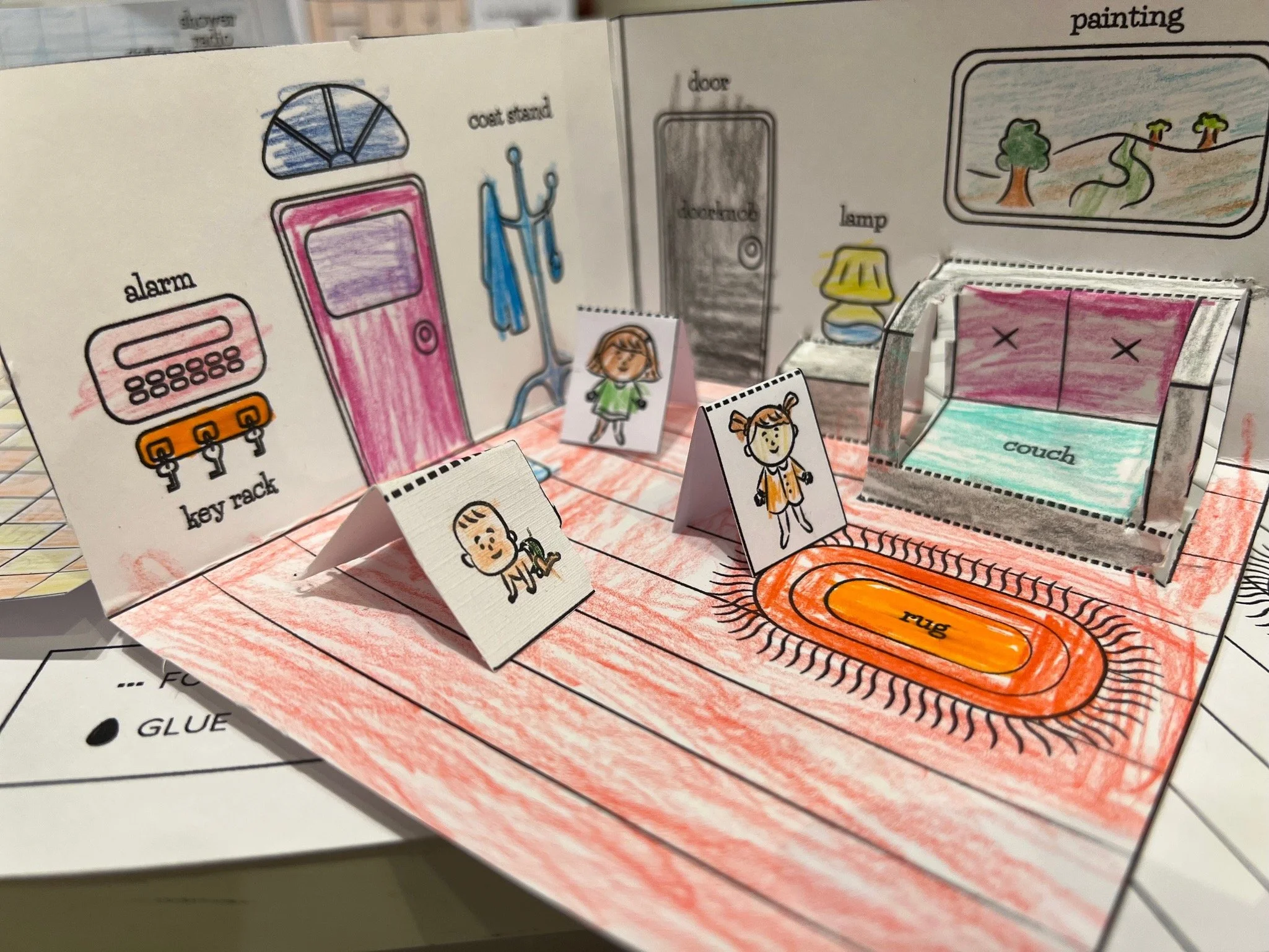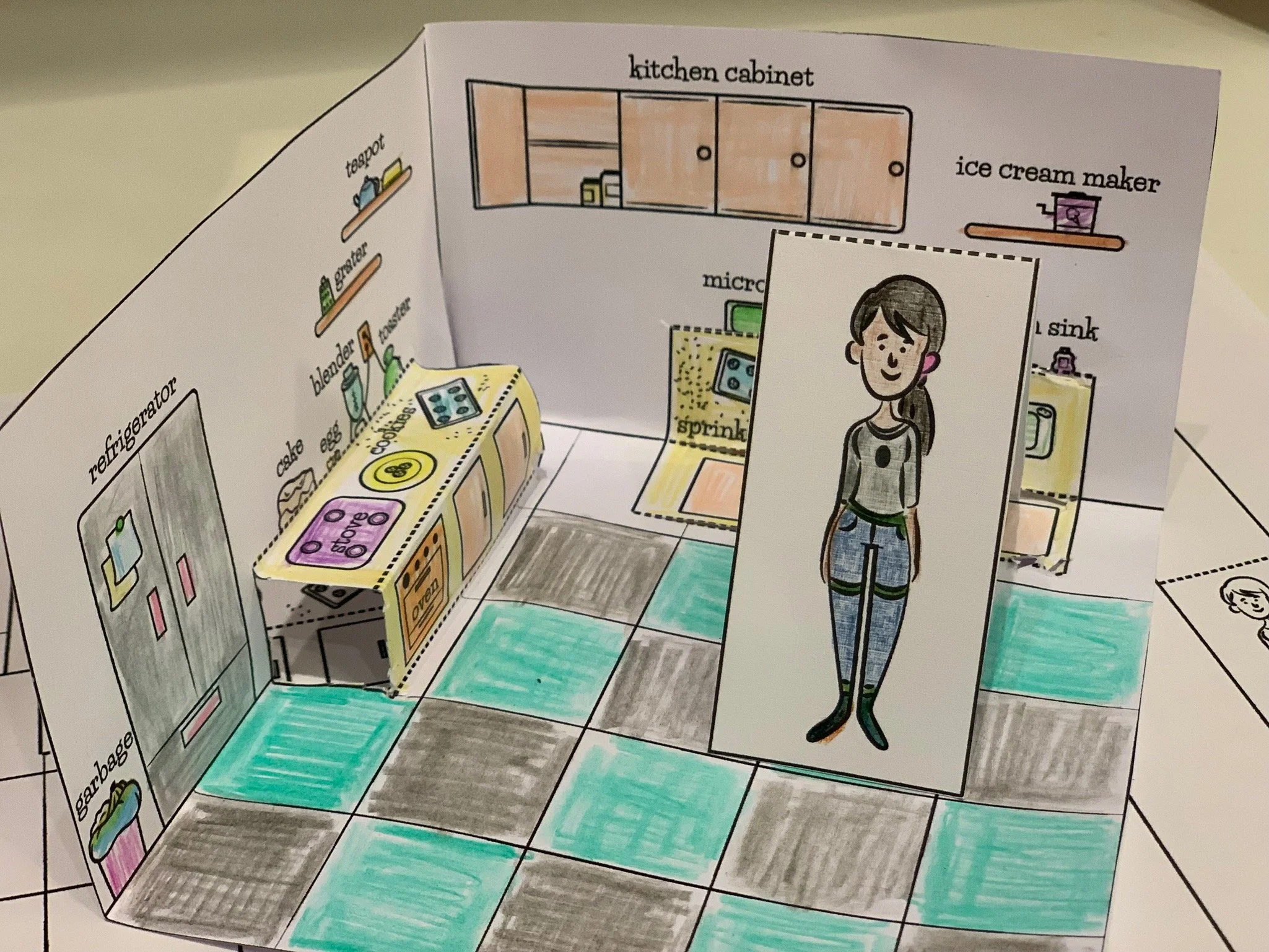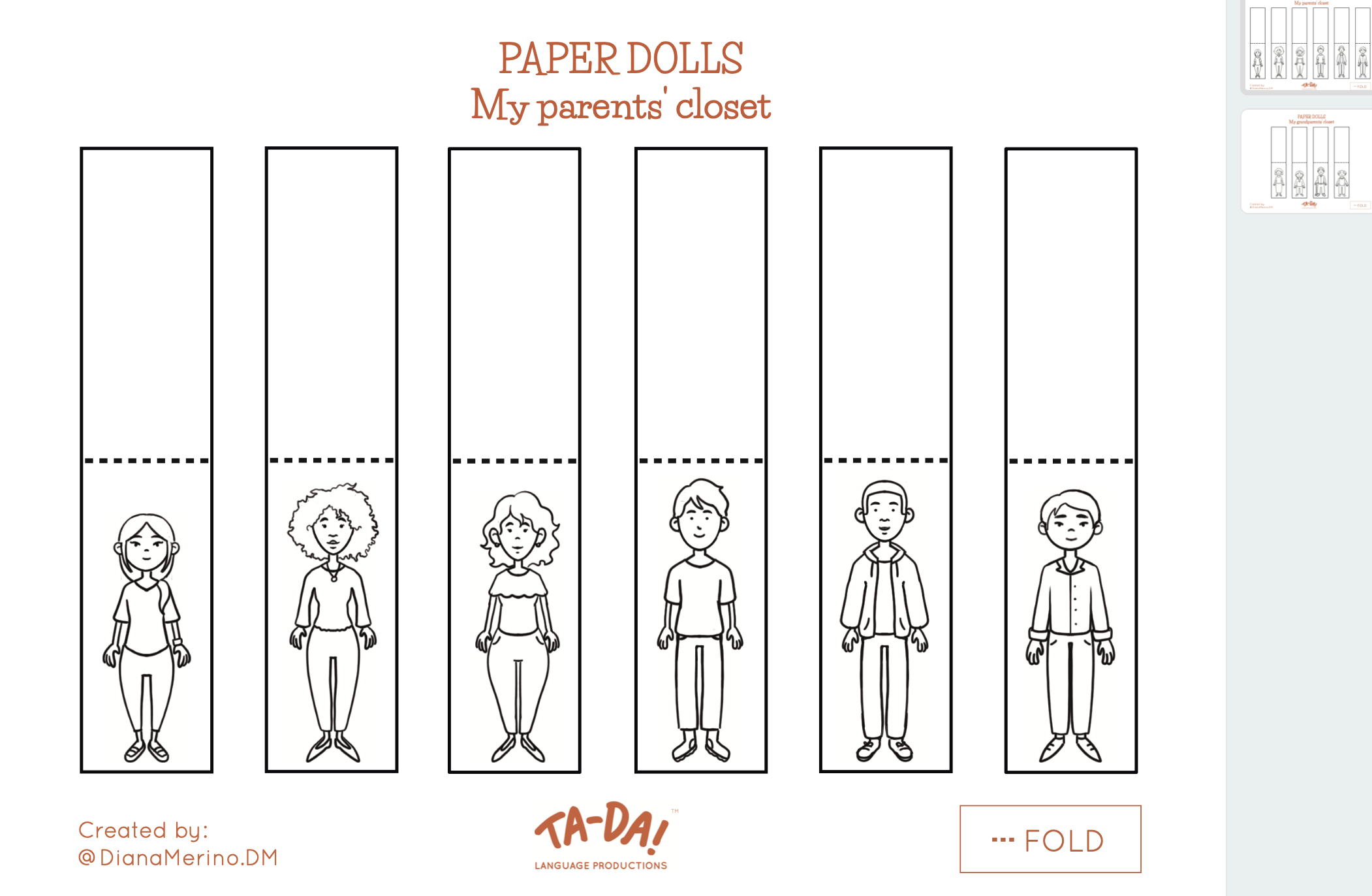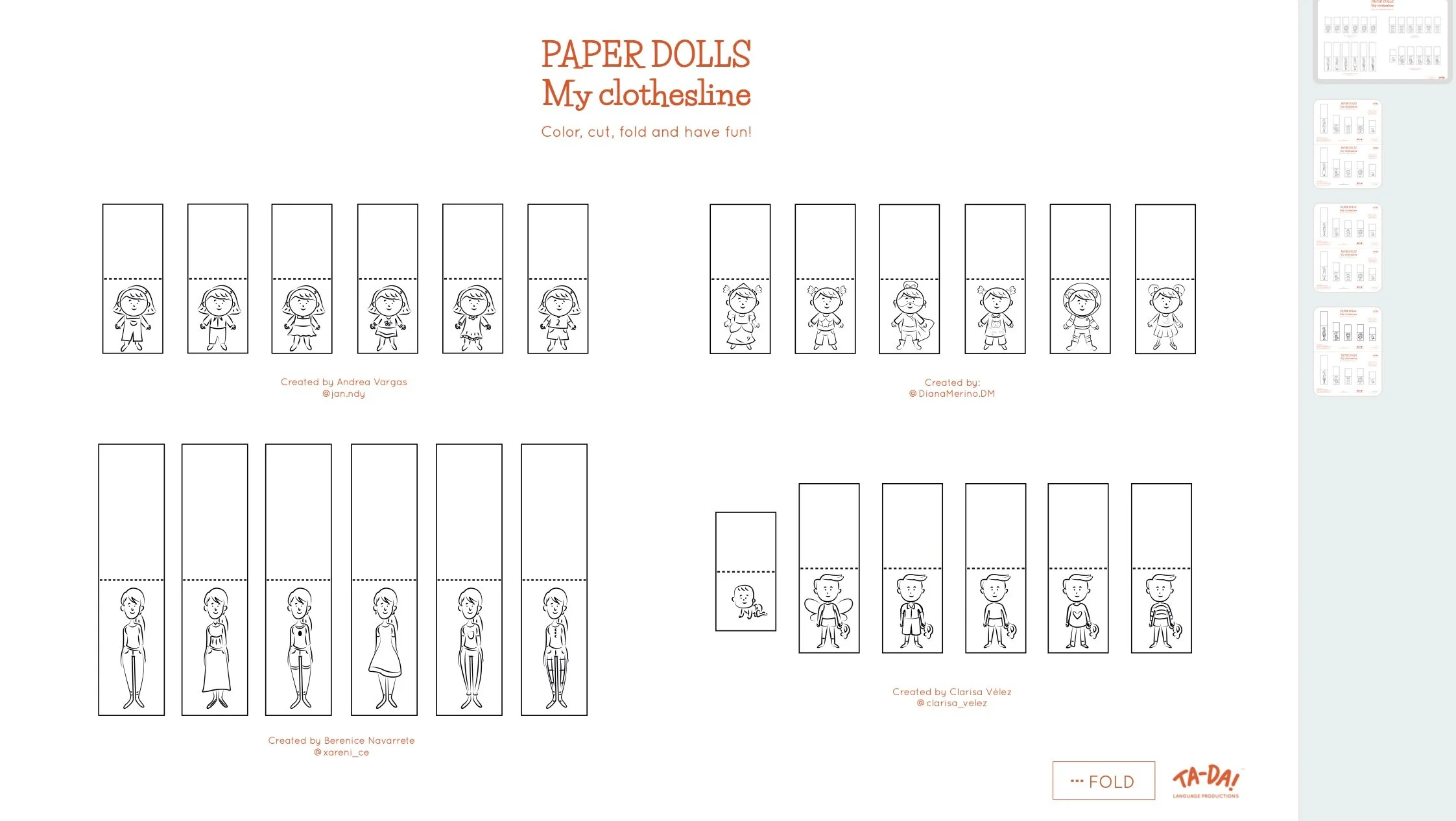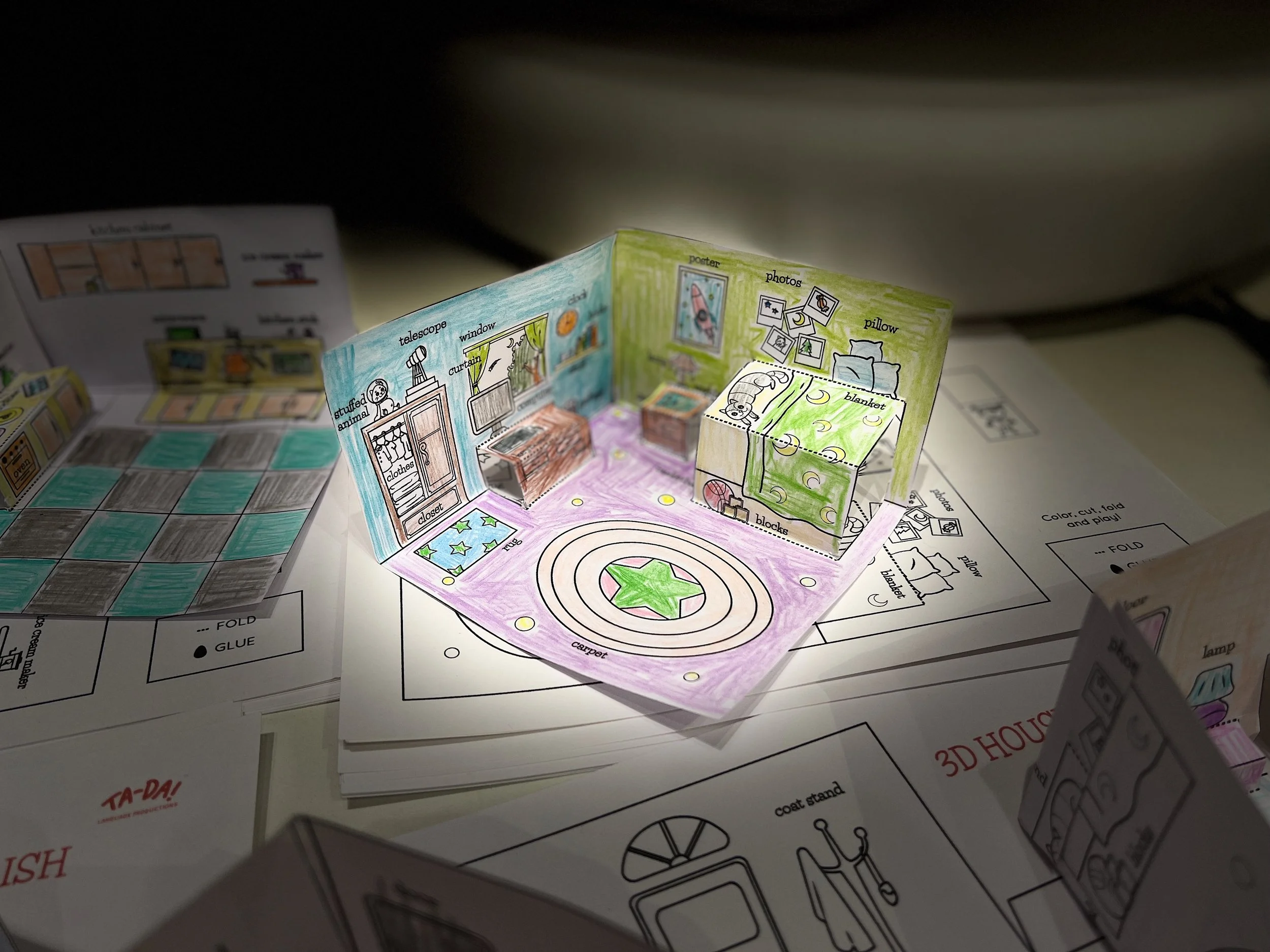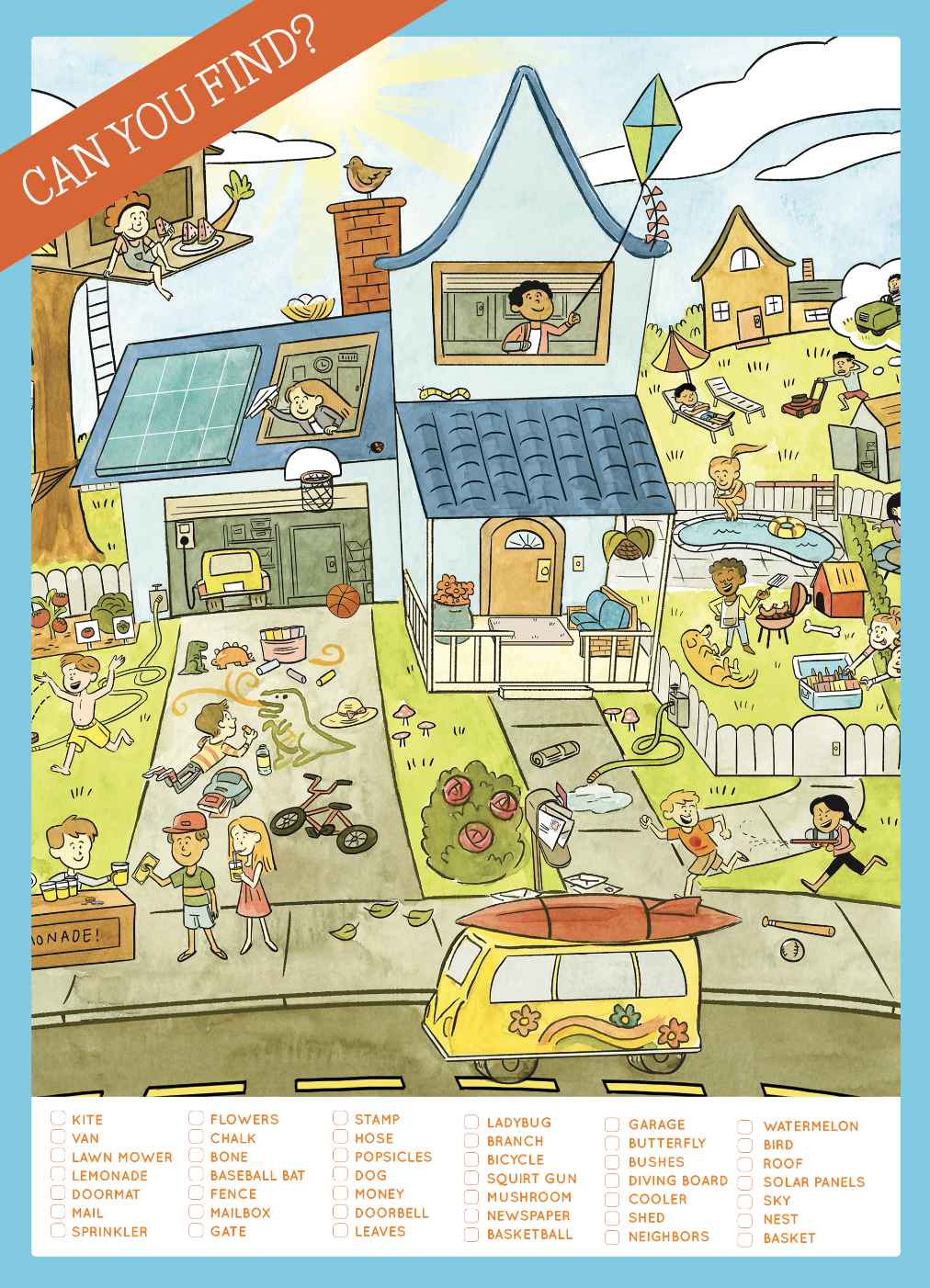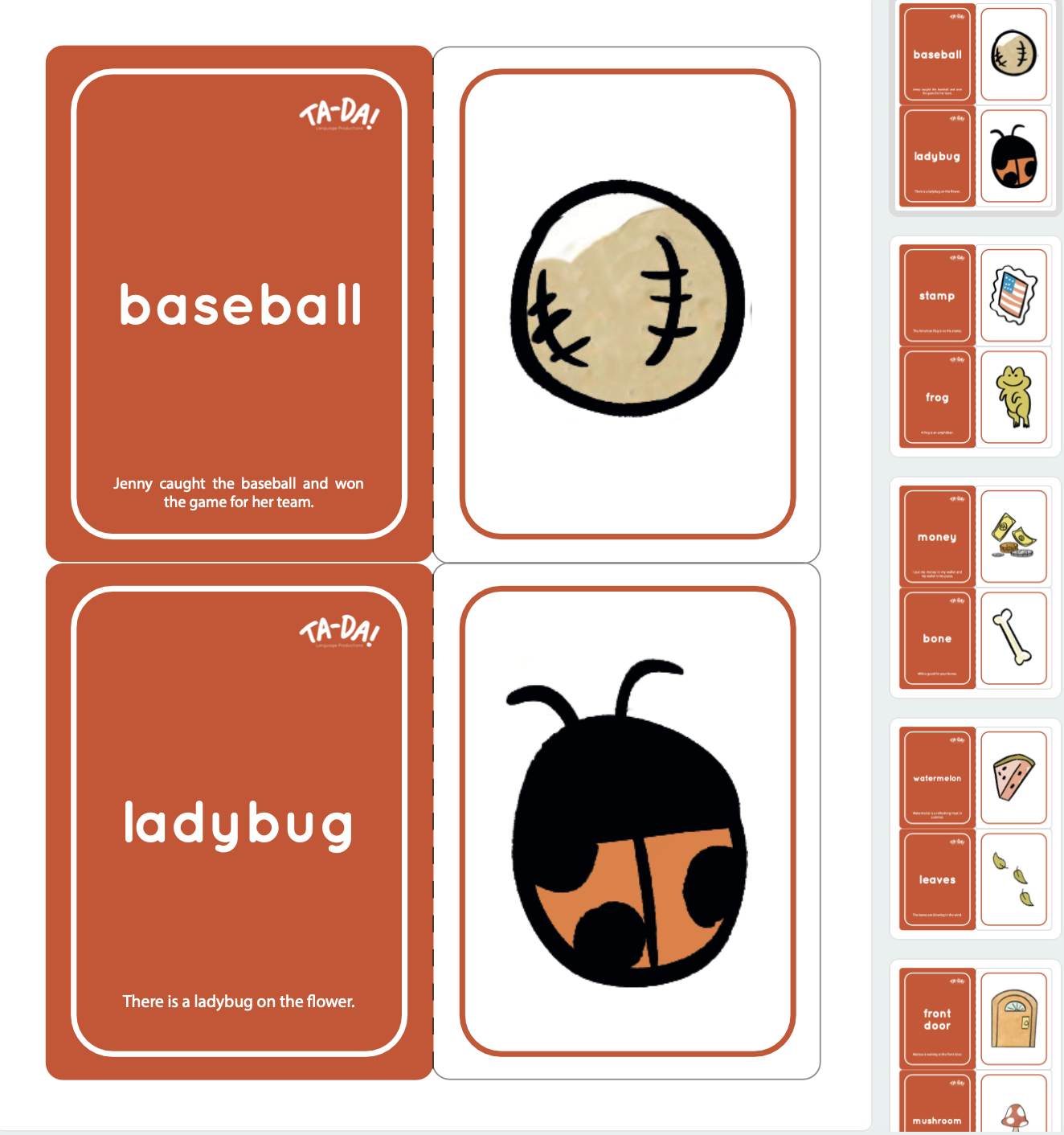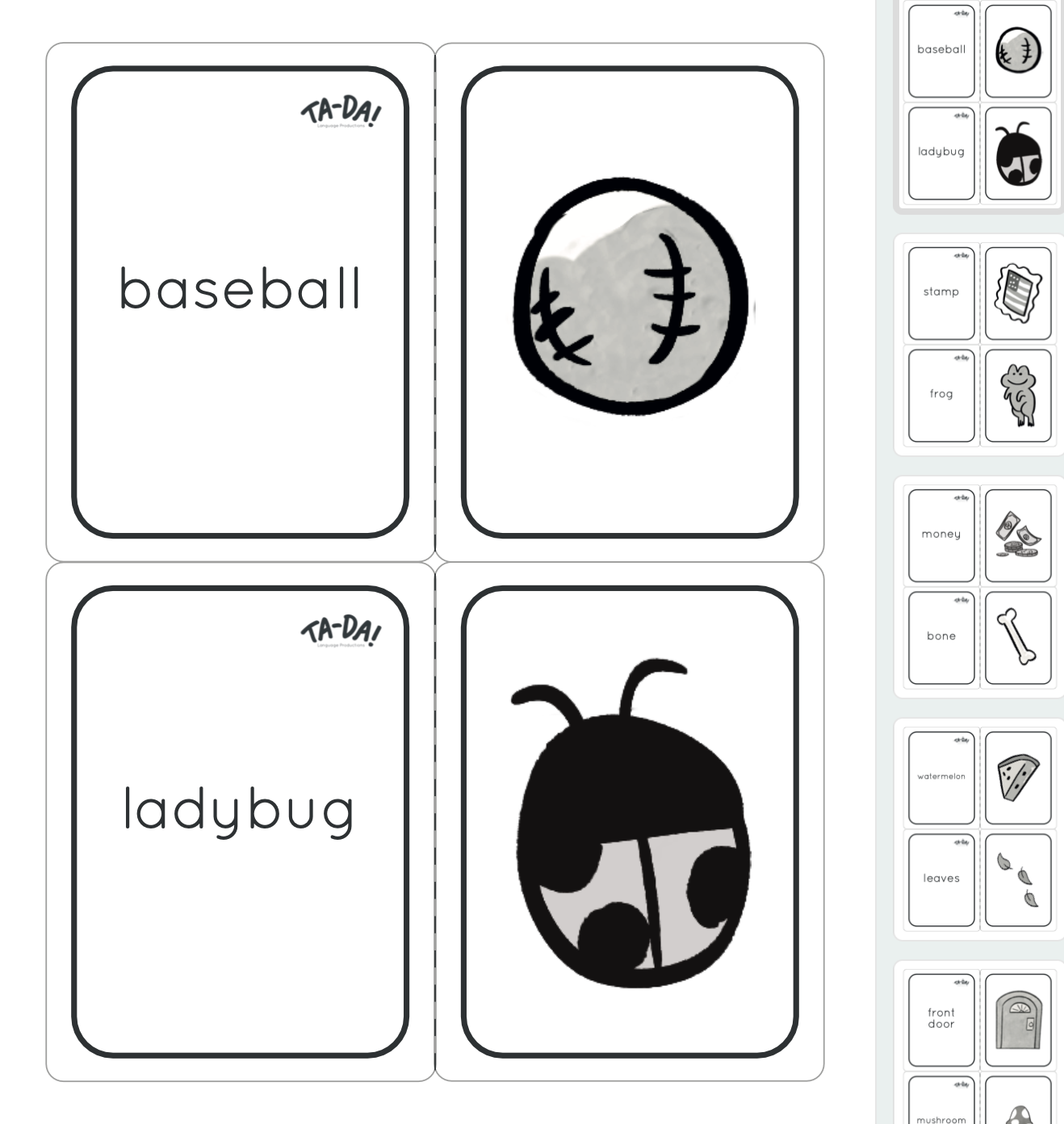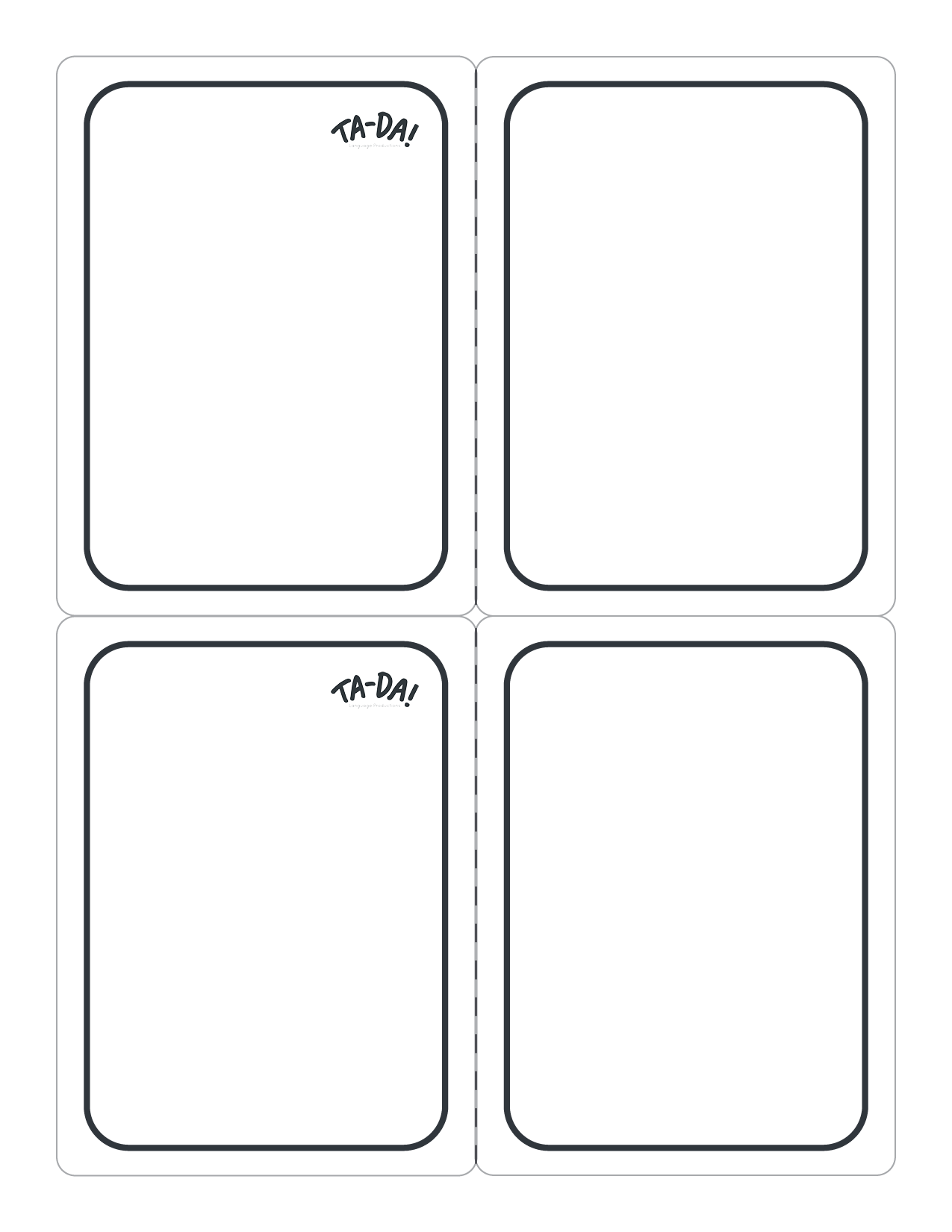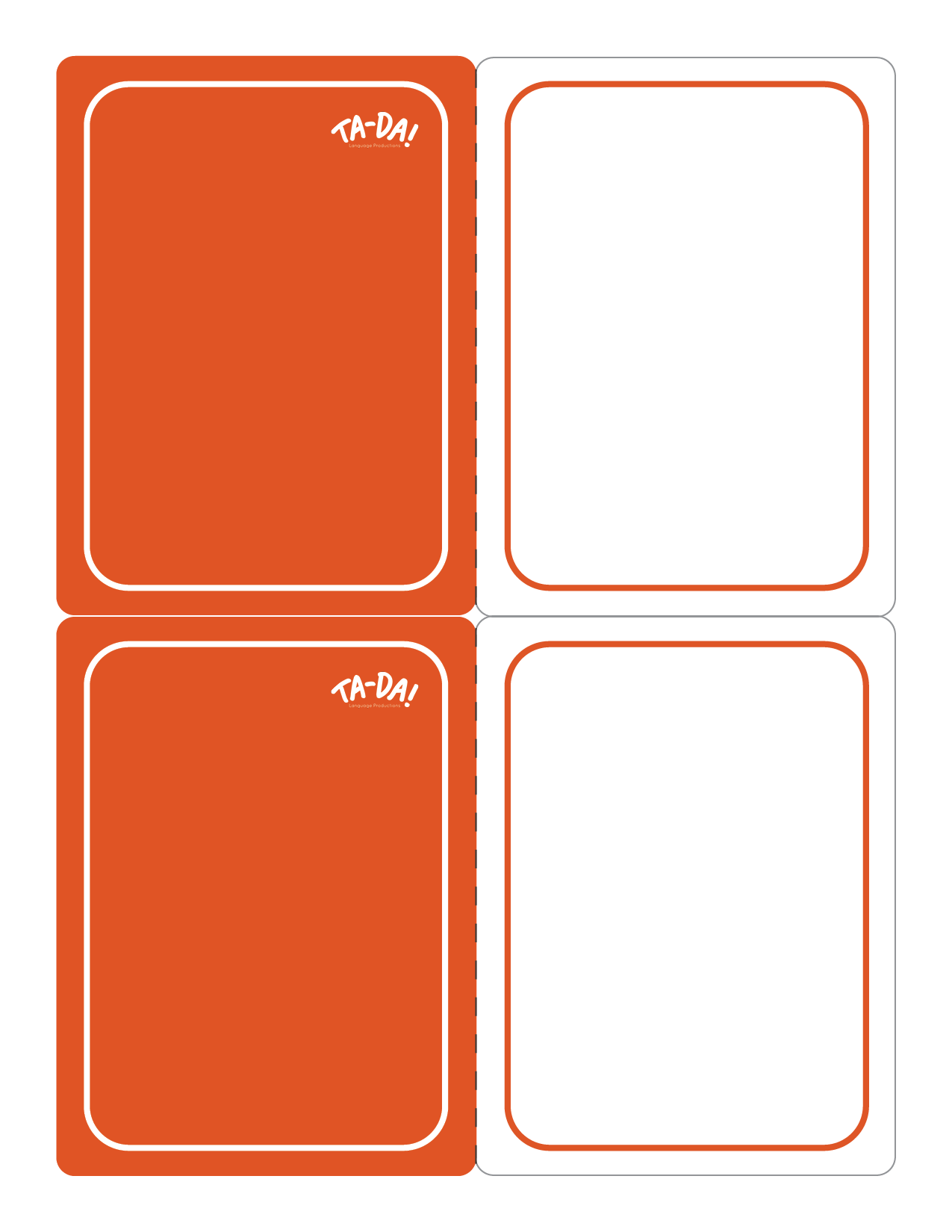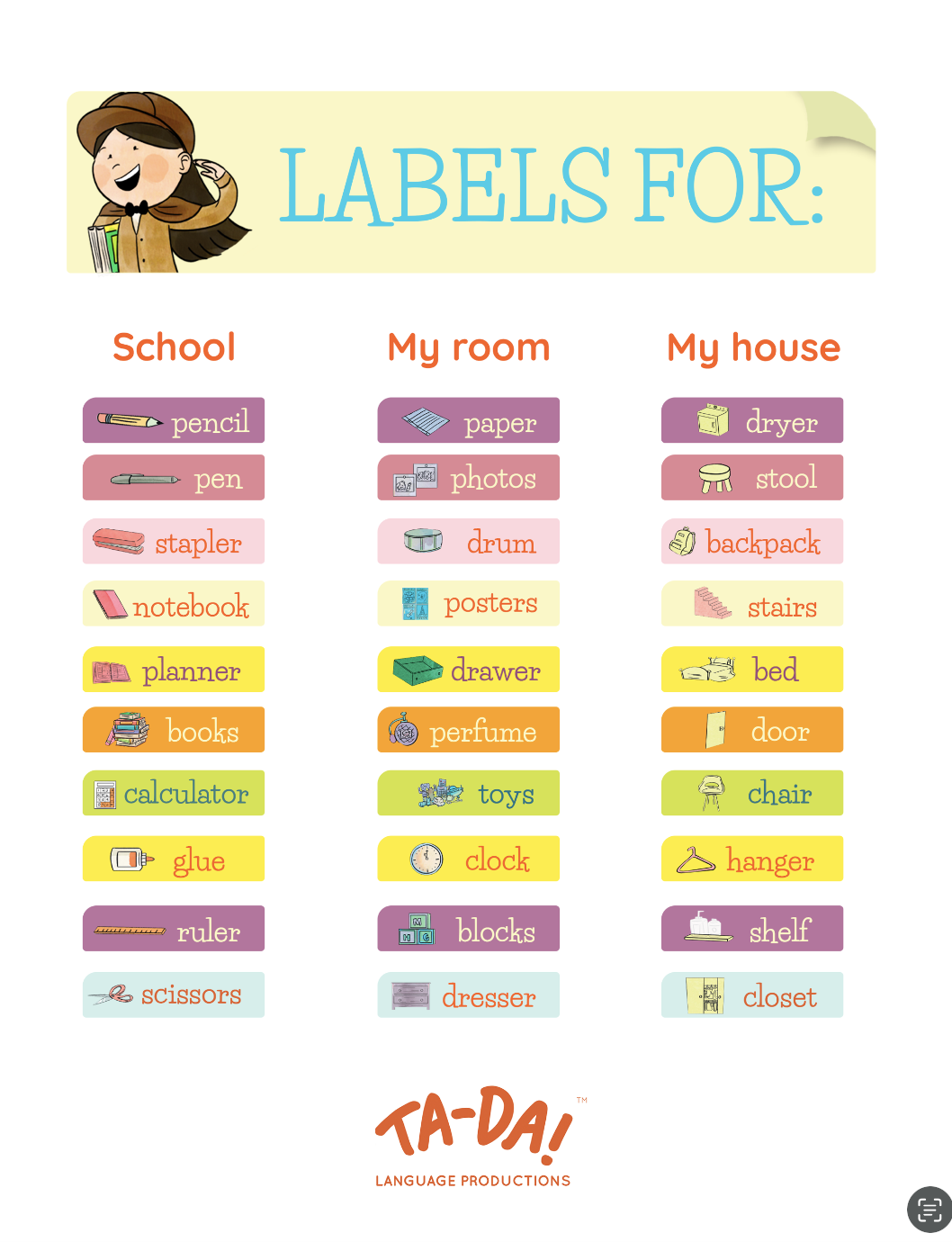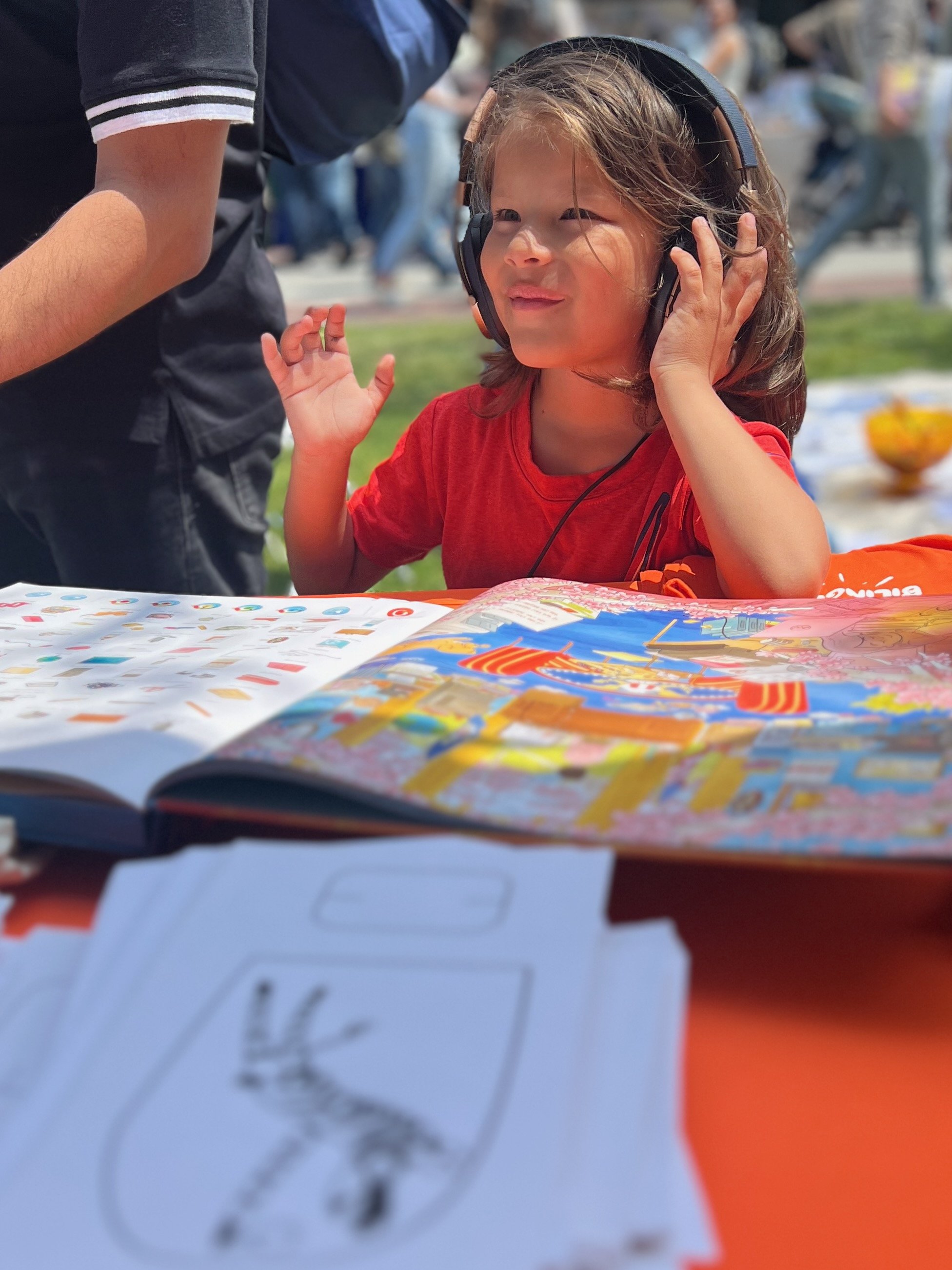
Open up a whole new world of language — with smart, talking books that teach English, Spanish, French, Mandarin Chinese & German to children 0-14+
Language Activities
Better Than Any Screen!
Why Choose TA-DA! Talking Books?
Multi-Sensory Learning: Combines touch, sound, and sight for an immersive, screen-free experience. Nothing, apart from packing your suitcase and traveling the world, touches this many senses simultaneously.
Real Voices: Features authentic pronunciations by native speakers from around the world. Like summoning Mary Poppins, these books bring the world, its people, their languages, and their cultures right into your children's laps. We personally know how empowering this is - especially when you, the adult, do not speak the target language.
Enhanced Life Skills: Boosts reading, comprehension, pronunciation, and confidence - which fast-tracks rockstar acquisition!
Eco-Friendly: Made with forest-friendly paper and child-safe materials, and safety-tested beyond industry standards.
Passionate, Award-Winning Team: TA-DA! is the brainchild and labor of love of language experts, leading music makers, and parents who care.
TA-DA! Makes Language Fun!
Which adventure will you choose?
TALKING BOOKS FOR AGES 0-5+:
Zoo Ocean Camping
Ancillaries for Zoo, Ocean and Camping Include:
FLASHCARD SETS
Expert Tips:
Tactile Cards: Enhance flashcards by adding textures. Stick on faux fur for a panda bear, a patch of smooth fabric for a dolphin, or a piece of tent-like material for camping-related words. It’s a tactile way to connect the word to the real world.
Themed Sounds: Encourage children to imitate the sound that the animal makes or, for non-animal cards, a sound associated with the object when they see the card. This auditory association helps cement the word in their memory.
Storytelling: Use the flashcard as a prompt to tell a short story or share an interesting fact. "Did you know lions live in groups called prides?" This method turns a simple word recognition exercise into a language-rich storytelling session.
Memory Rhymes: Invent catchy rhymes that describe the flashcard’s image or create a fun story about it. "Here sits a lion, mighty and brave, king of the jungle, he loves to roar and wave!"
Memory Rhymes II: Create simple rhymes for the children to recite when they turn or choose a card, such as "Flip, flip, what do you see? Is there a match? Let’s see, let’s see!"
Match and Move: To add a physical element, have the child perform a simple action related to the card. For example, stretch up high like a giraffe, wiggle like a fish, or pretend to roast a marshmallow.
Use Thematic Props: Pair the flashcard with a related prop. Hold a small stuffed lion while teaching the word "lion" or a shell when teaching "sea". It’s an engaging way to enhance the learning experience.
Label Reading: Practice reading the word on each card aloud. Use your finger to trace the letters, helping children connect the written word with its pronunciation and meaning.
Turn Taking and Sharing: If using the cards in a group, encourage children to take turns picking and explaining a card. This teaches patience and gives each child a chance to shine.
Language Layering: After listening to the word from the talking book, encourage parents to repeat the word first in their native language and then in the target language. This ‘language layering’ technique helps the child associate the new word with one they already know, making it less intimidating.
Cultural Connection: Introduce a cultural aspect related to the word. For instance, if the flashcard shows a panda, talk about where pandas live and what they eat, or if it’s an igloo, discuss how and where igloos are built. This cultural storytelling can be done in the parent’s native language to create a richer learning context.
Remember, the goal of introducing a new language through these flashcards is to create a positive and stress-free learning experience. It’s perfectly fine to conduct activities and discussions in your native language; the important aspect is the gentle exposure to the sights and sounds of a new language. This approach ensures that the 12 words on these flashcards become a beloved part of your child’s vocabulary and that the language itself becomes associated with joy and curiosity.
MEMORY GAMES
Expert Tips:
Guided Imagery Relaxation: Before starting the game, have the children close their eyes while you describe one of the themed environments in detail. For instance, describe the sounds and sights of a zoo visit, the feeling of ocean waves, or the smell of the forest while camping. This can relax children and get them excited about the game, enhancing their focus and memory retention.
Personalized Backdrops: Encourage children to draw or color a thematic scene on a large piece of paper where they can place the cards for the game. A zoo scene with cages and trees, an underwater seascape, or a campsite can make the game more engaging.
DIY Card Holders: Guide children to create their own card holders with themed decorations. For instance, they could make a simple stand with ocean waves and sea creatures for the ocean theme or a mini zoo enclosure for the zoo theme.
Mix and Match with Realia: Integrate real objects related to the themes with the cards. For example, include a small stuffed animal for the zoo theme, a shell for the ocean theme, or a mini flashlight for camping. After finding a match, children can pair the card with the object.
Flashlight Fun: Turn off the lights and play the memory game using a flashlight to find and illuminate the cards. This can be especially fun with the camping theme, mimicking a nighttime adventure.
Card Scavenger Hunt: Hide the cards around the room and have the children find one, then return to the main playing area to find its match among a laid-out set of cards.
Themed Snacks: Incorporate snacks that align with the theme to enjoy after gameplay. Animal crackers for the zoo, goldfish crackers for the ocean, and s'mores for camping could be fun.
Storytime Integration: Pair the memory game with storytime, where each matched pair of cards leads to a page or passage in a story that connects with the theme.
Themed Music: Play thematic music in the background while playing the game. Animal sounds or jungle music for the zoo, ocean waves or aquatic music for the ocean, and nature sounds or campfire songs for camping can enrich the experience.
Puzzle Piece Rewards: Each time a child makes a match, they earn a piece of a puzzle related to the theme. Completing the puzzle can be a goal that complements the memory game.
Deeper Dive, Language Learning: For bilingual households or classrooms, use the target language to describe the pictures on the cards. This can reinforce new vocabulary and language skills while playing the game.
Positive Reinforcement: Offer praise for effort, not just for finding a pair, to encourage a positive learning environment. Use phrases like “Great try!” or “You're remembering well!”
Along with these engaging activities, it's key to remember that exposure to language should be a delightful experience. Whether the memory game is played in the target language or the native language of the child, the focus should be on the joy of learning and the excitement of discovery. The use of their native language ensures that children are comfortable and supported while also being introduced to the new language in a stress-free way. By providing a gentle introduction to language, these memory games will not only help children learn new words but also create fond memories associated with the language learning process.
BINGO GAMES
Expert Tips:
Cultural Immersion: Use currency or coins from the target country to expose your child to the culture while playing bingo.
Thematic Bingo Dabbers: Use themed markers for bingo dabbers. For instance, use animal stamps for a zoo theme, small seashells for an ocean theme, or pine cones for a camping theme. This adds a tactile and visual element that ties back to the theme.
Language Practice: Take it a step further by using the occasion to count or do math in the target language, enhancing language skills while playing.
Personalization: Print the bingo cards in greyscale and allow your child to color them, fostering creativity and ownership of the project.
Durability: Laminate the cards to keep them clean and long-lasting, ensuring hours of repeated play.
Language Reinforcement: The instructions are also provided in the target language, providing additional language practice opportunities if you're able to read them together.
Rewarding Exploration: Offer a small incentive for kids to speak or ask questions about the items on the bingo cards in the target language, such as “What is this?” or “How do you say that?” Encouraging curiosity will make the learning process more interactive and rewarding.
Remember, the essence of learning with these bingo games is not just about winning or mastering the language; it's about immersing in the joy of learning and celebrating cultural diversity. The laughter, the shared moments of excitement, and the gentle exposure to new words and numbers in the target language will create a warm and memorable learning environment. This joyful approach ensures that your child associates language learning with positive emotions and experiences, laying the foundation for a lifelong appreciation for new languages and cultures.
3D PAPER CRAFTING
Expert Tips:
Fine Motor Skills: Encourage children to participate in cutting out the images (with safety scissors and adult supervision) and folding the paper. This can help develop their fine motor skills and hand-eye coordination.
Environmental Storytelling: After crafting the scenes, children can use the 3D paper figures to act out stories from their Talking Books, or they can create their own, fostering both creativity and language skills.
Cultural Exploration: Incorporate fun facts about the instruments’ or objects' origins, their roles in their native ecosystems, or their significance in various cultures to spark curiosity and cultural appreciation.
Color and Design: Let children choose their color schemes and decorations to express their individual styles. Encourage them to draw additional elements or background details related to each theme.
Puppet Play: Turn the paper figures into puppets by attaching them to sticks or straws. Children can use them to put on a play, encouraging expressive language use and storytelling.
Articulation Practice: Use the paper scenes to practice pronunciation of tricky words from the Talking Books. Repetition through play is a fun way to perfect new sounds.
Interactive Display: Set up a space where the children can display their crafted scenes. It can be a 'museum' where they give tours, using vocabulary from the Talking Books to describe their exhibits.
Remember, the key to these paper crafting activities is not just in the making and playing but in the opportunities they present for language immersion, cultural exploration, and creative expression. Through these imaginative plays and crafting sessions, children aren't just learning new words; they're experiencing the joy of bringing a language to life through art and play. It's this positive, hands-on approach that will leave a lasting impression on young learners, fostering a deep love for languages and cultures.
COLORING BOOKS
Expert Tips/Suggestions:
Encourage creativity without pressure.
Enhance the experience by offering a variety of artistic mediums such as jumbo crayons, washable markers, or glitter paint.
Integrate language learning by providing reading materials in the target language, such as magazines or newspapers, for decoupage.
Model the enjoyment of tracing written words and displaying completed artwork proudly, reinforcing their importance within the household. (For more tactile time - write the words in sand or paint.)
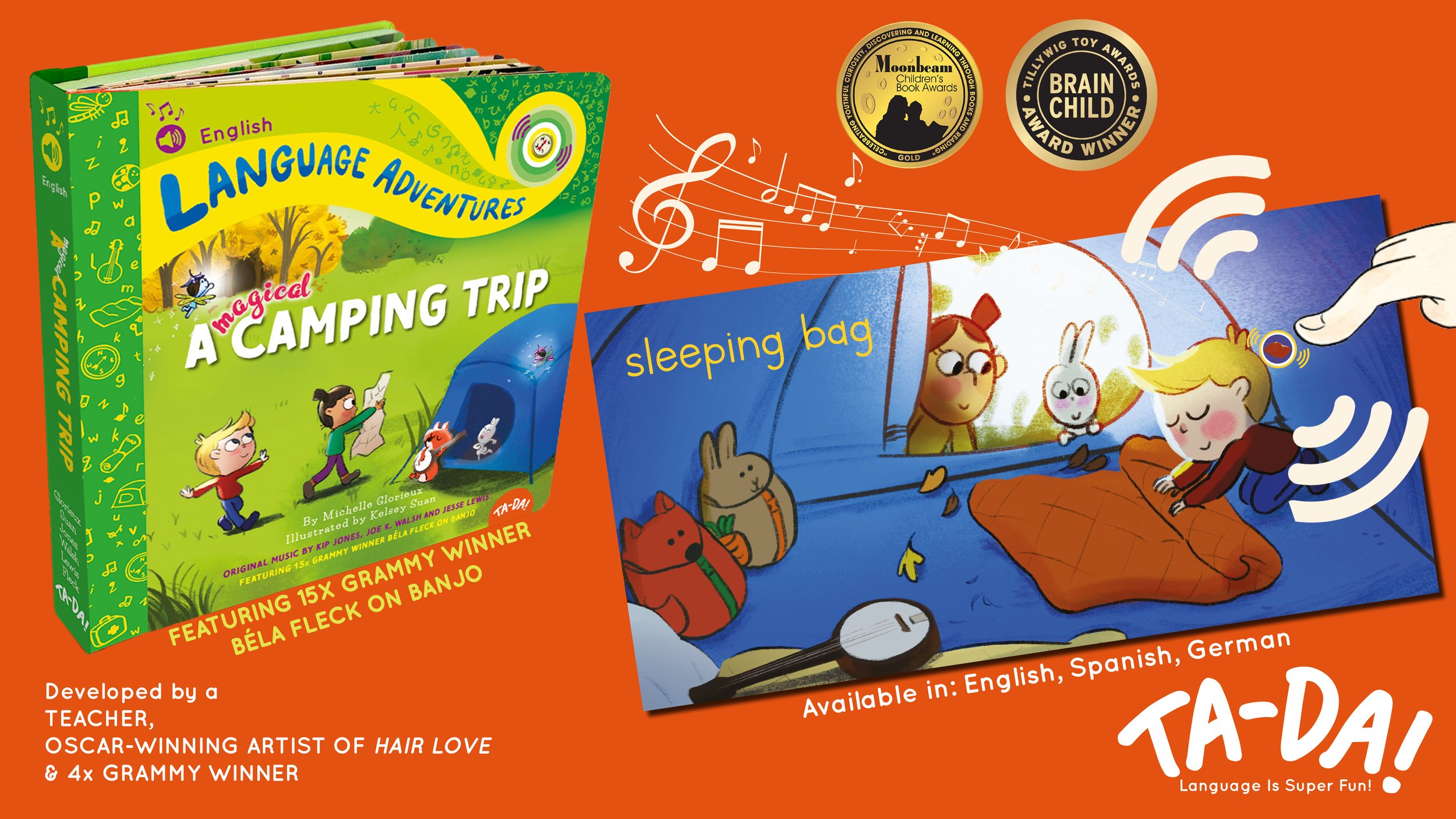
Early Literacy
Word Search
Just Click
Banjo Crafting with
Béla Fleck!
CAMPING LESSON PLANS
Just click and print.
Cultural
Camping
Fireside Cooking
Special Thanks to Béla Fleck
A heartfelt thank you to Béla Fleck and his family for believing in a simple mompreneur with big dreams. Your kindness and support, despite never having met, is truly inspiring.
As a token of our gratitude, we are offering these free activities to make learning fun and accessible. Together, we are giving back to children, especially those in schools in need and orphanages.
Thank you, Béla, for helping us make a difference!
-Michelle Glorieux
Founder and CEO of TA-DA!
15x Grammy-winning Béla Fleck
No adventure would be complete without
MUSIC
“The artwork in all three books is exceptional, each glorious full-page illustration [builds] an adventure unto itself that children find absolutely captivating”
Dan Levy, Director of Tillywig Toy and Media Awards
“The images are adorable and help create a description of the story. My LO really took to it and I have opened the book just to listen to the music when by myself.”
Gwendhal
“WONDERFUL, JOYFUL SENSORY EXPERIENCE! MY GRANDSON'S FAVORITE!”
-Amazon Reviewer
A Funny Day at the Zoo
Paper Zoo!
Click above and download the PDF.
Ensure the kids have ample hands-on, creative play time with their new vocabulary.
Just click, print, and you’re off to creating your very own zoo!
This paper craft was created with tremendous love by the Language Adventures series illustrator and contributing artist of the Oscar-winning animated short, Kelsey Suan.
Tip: Use thick paper for a better quality, long-lasting structure.
Tip: Bigger is better! Print as large as your printer can manage.
ZOO LESSON PLANS
Just click and print.
A Funny Day at the Zoo!
Ensure your children have ample hands-on, creative play time with their new vocabulary. Just click, print, and you’re off to creating your very own zoo!
Crocodile
Gorilla
Lion
Monkey
Panda
Peacock
Zebra
Hippopotamus
OCEAN LESSON PLANS
Just click and print.
TALKING BOOKS FOR AGES 6+:
Available Now
Coming Soon
Meet the World’s First
TALKING Word Book
Featuring a whopping 1000 words • 2 dozen different native speakers • 10 hours audio in high-def!
TEACHERS’ RESOURCE GUIDE
3D PAPER HOUSE
Click, Print, Craft, Learn. Love!
This 3D paper craft and its matching video tutorial was created with tremendous love by awesome intern, Berenice Navarrete Camacho of Mexico City.
Click above to download the PDF.
3D ROOMS IN A HOUSE
This 3D paper craft and its matching video tutorial was created with tremendous love by awesome intern, Berenice Navarrete Camacho of Mexico City.
DIVERSE PAPER DOLLS
Enhance cultural understanding with diverse paper dolls, promoting inclusivity — and providing rich encounters with vocabulary.
Tip: Use strong, sturdy paper - and print as big as possible!
This paper craft was created with tremendous love by awesome interns, Berenice Navarrete Camacho, Andrea Vargas, Clarisa Vélez, and Diana Merino of Mexico City, Mexico while art students at TA-DA! partner, Universidad Nacional Autónoma de México.
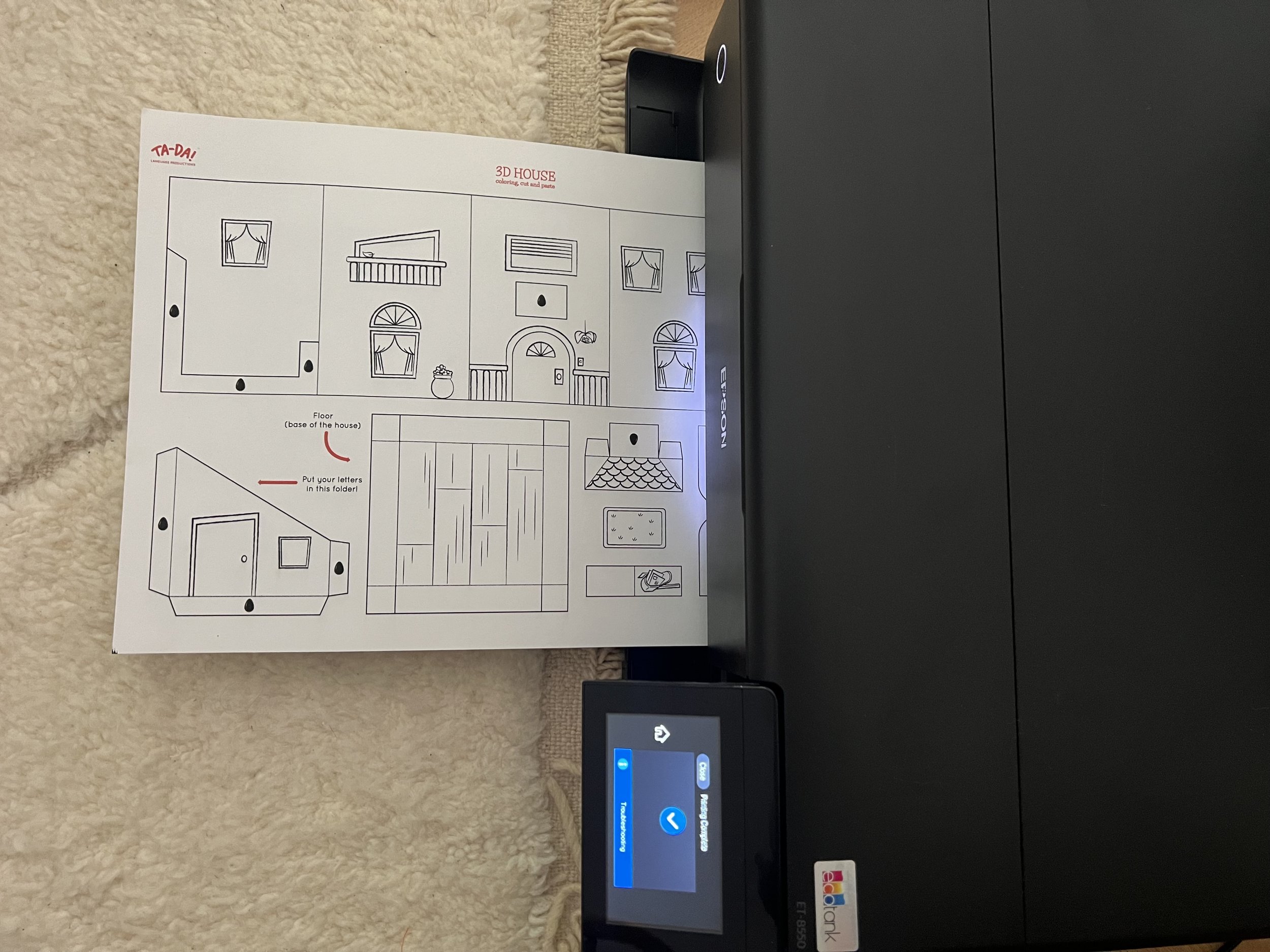
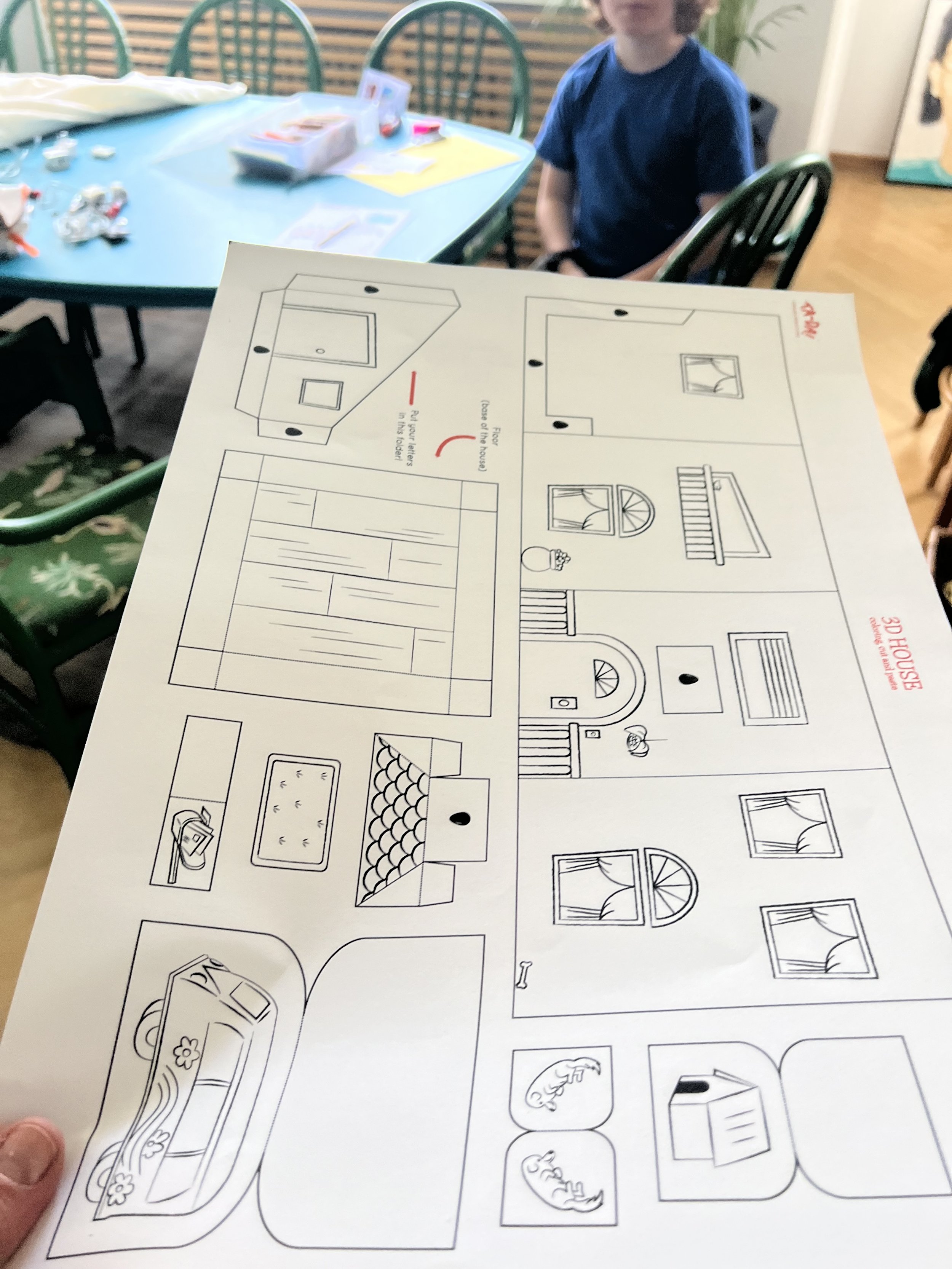
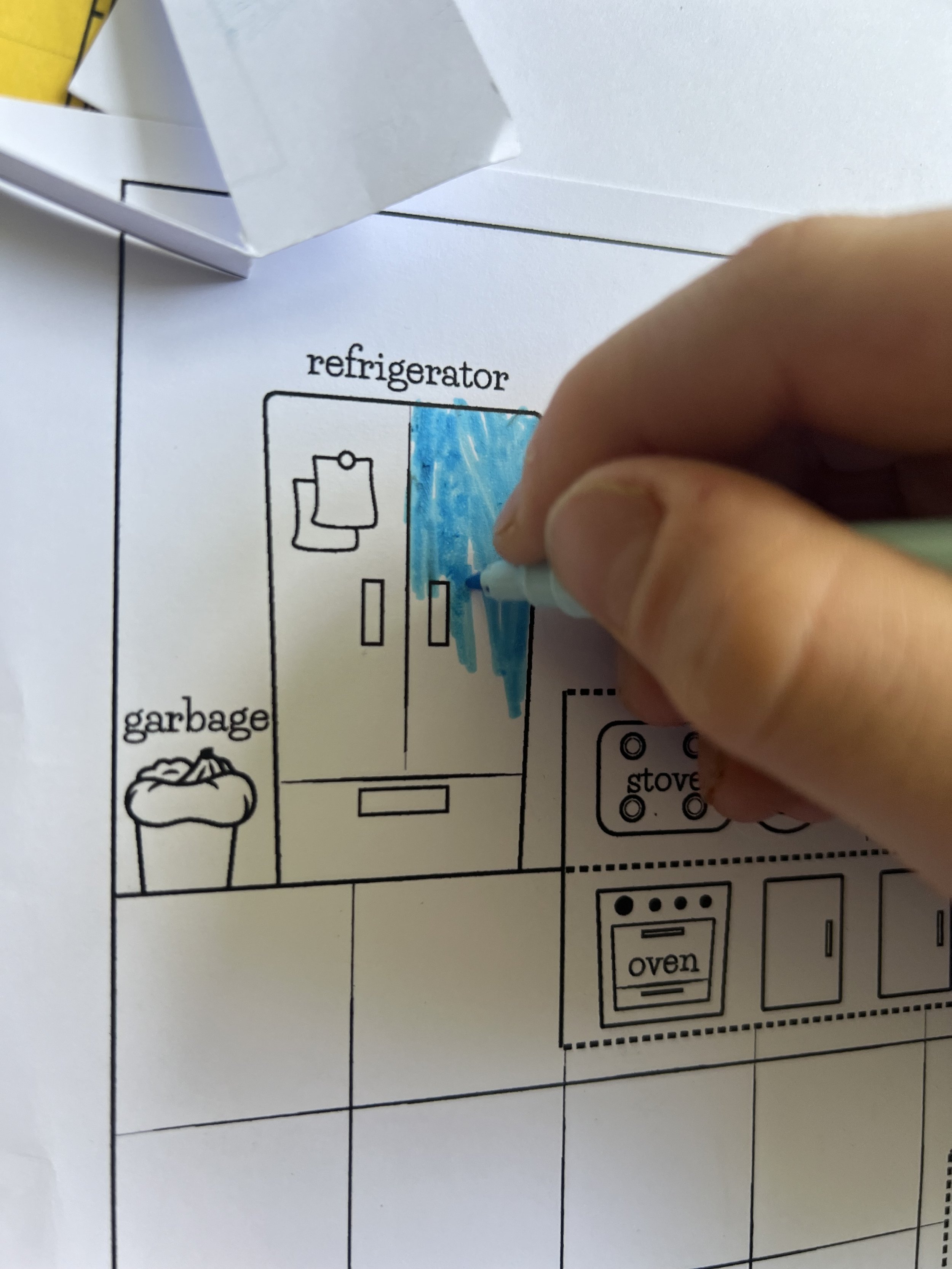
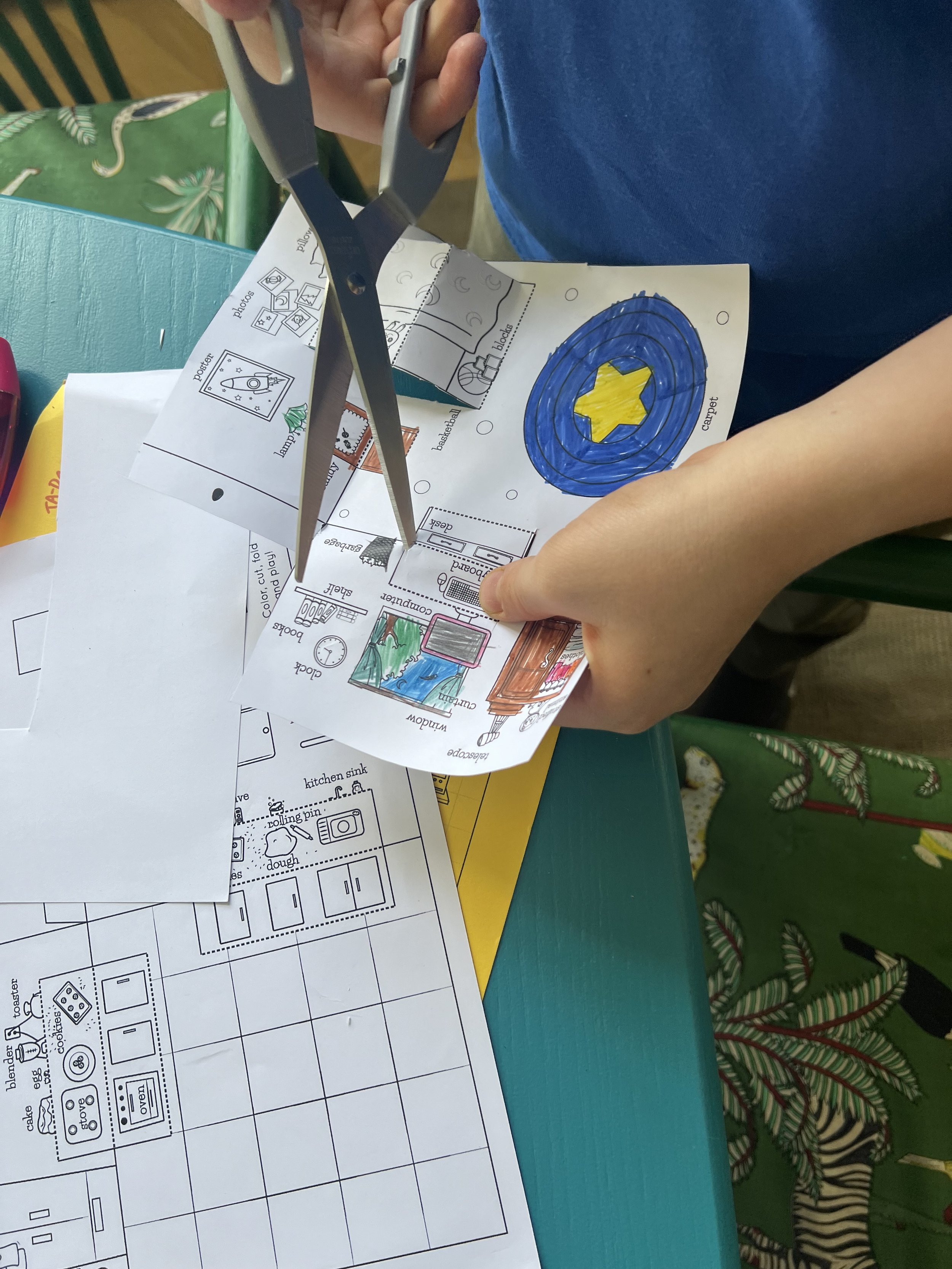

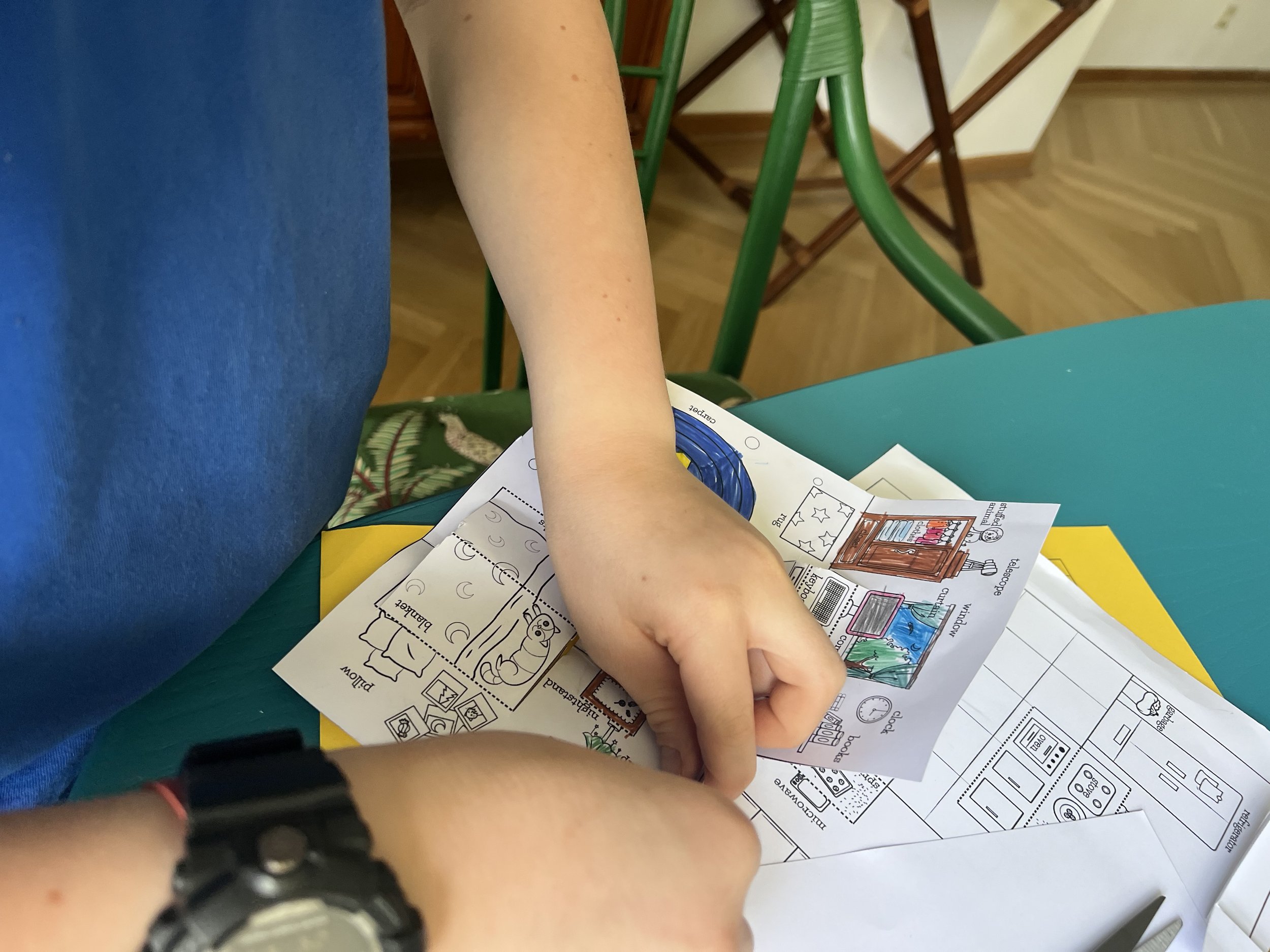
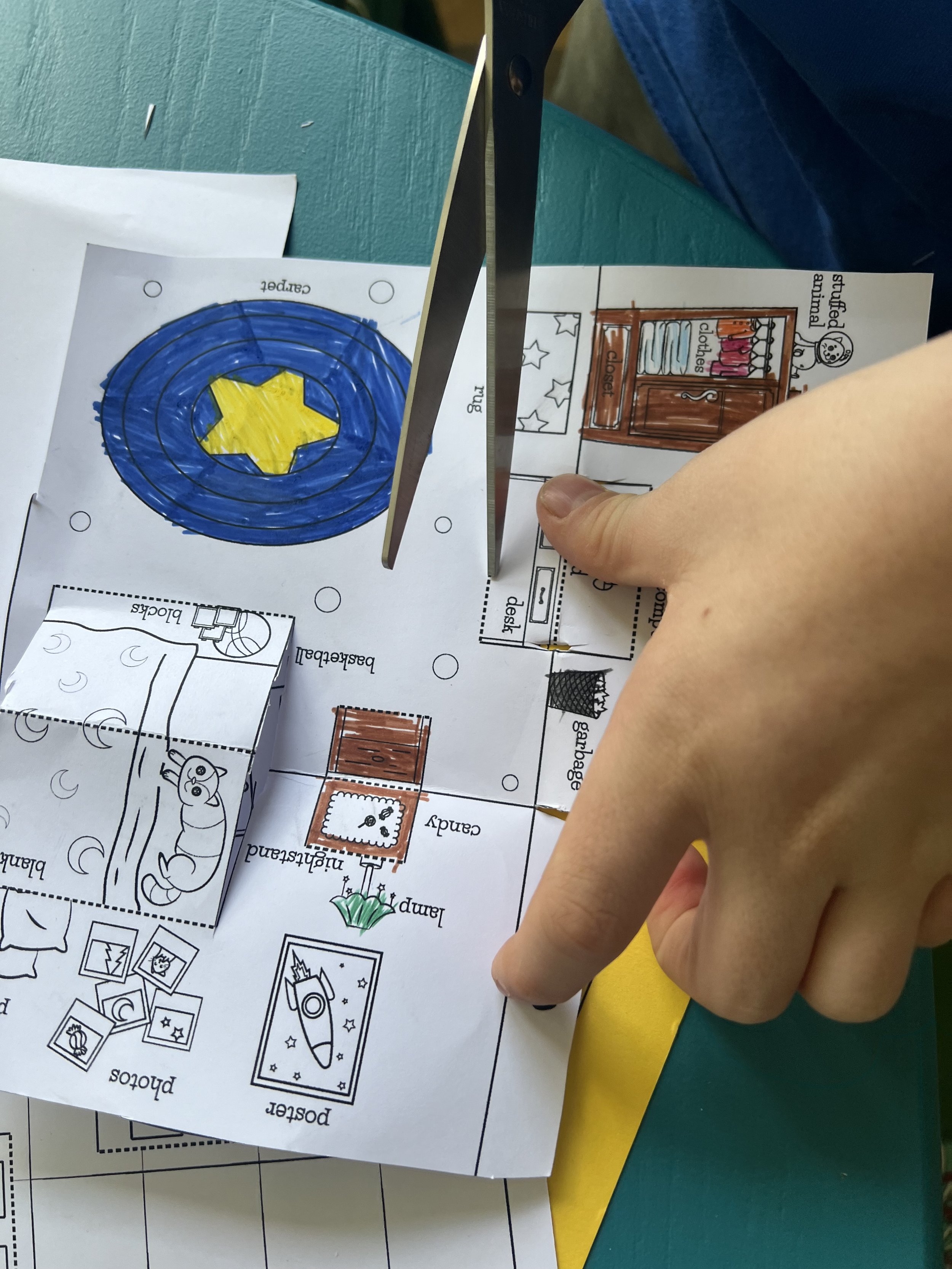
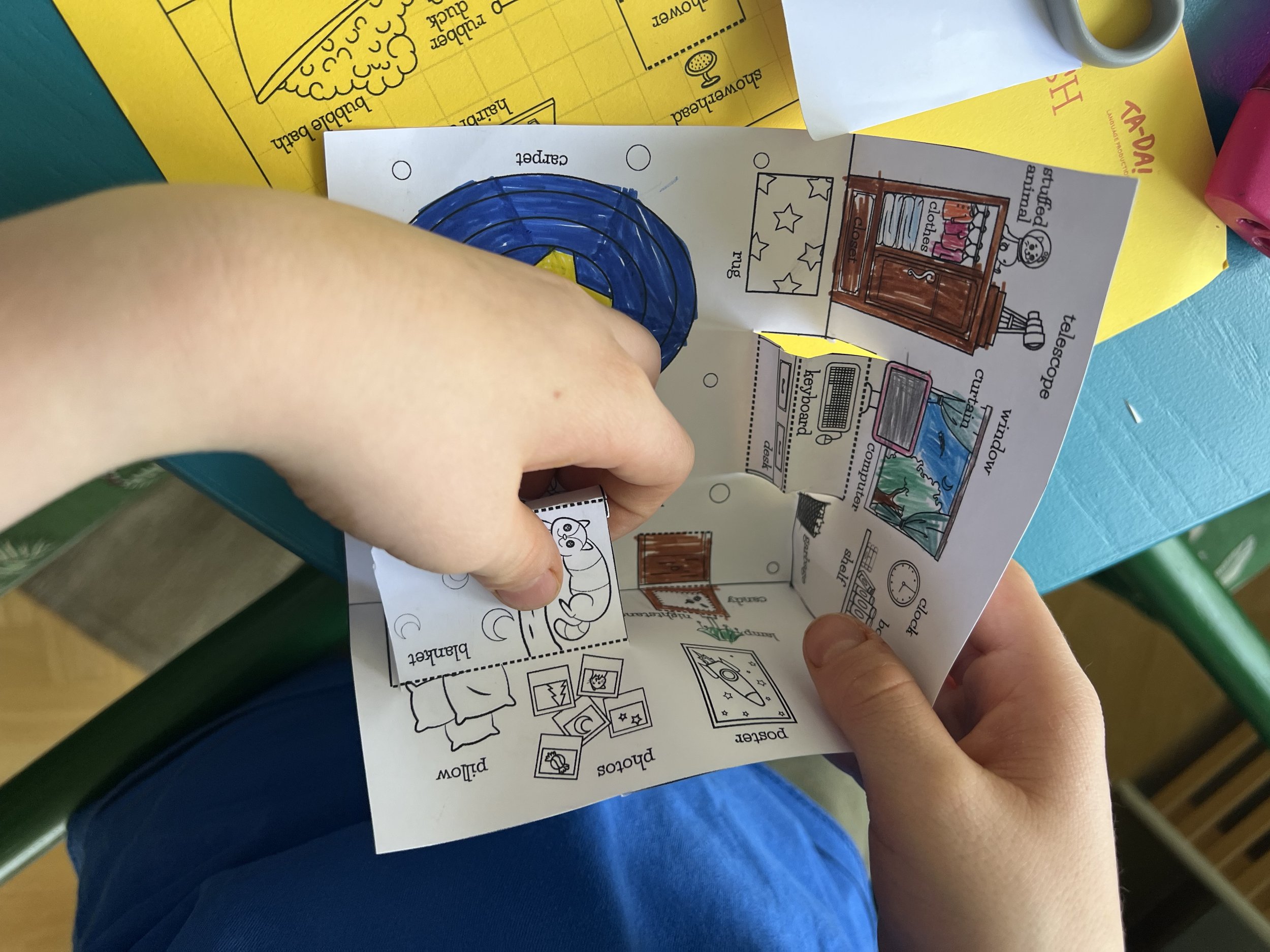

SEEK-N-FIND POSTERS
Laminate the provided seek-and-find posters to engage students in interactive language learning games. In this way, these durable posters can be used repeatedly to reinforce vocabulary in a fun, hands-on manner. Write, erase, repeat!
Tip: As a classroom project, assign words individually or in small groups, and have students create their own posters you can laminate and use in class, ensuring new material and fresh encounters every week of the year with you only flipping the switch on the laminator - and students’ confidence boosted by their participation.
This resource was created by Clarisa Vélez of Universidad Nacional Autónoma de México during her internship with TA-DA!
FLASHCARDS
Tip:
Flashcard Fun! Utilize the TA-DA! matching flashcards’ template to reinforce vocabulary kinesthetically. Encourage students to use these words to craft their own sentences and share their creations with the class. You can then use those custom flashcards in class for the multitude of games we’ve suggested in the Teachers’ Resource Guide Found in this Bundle.
These beautiful flashcards were created by awesome intern, Irene Hernandez of Mexico City while she was an art student at Universidad Nacional Autónoma de México and an intern at TA-DA!
Blank flashcard template in B&W:
100 ready-made flashcards in B&W:
Blank flashcard template in color:
100 ready-made flashcards in color:
WORD LABELS
Tip:
Expand on the TA-DA! labels as a class using the TA-DA! matching Labels template, followed by a fun, collective effort in labeling the classroom. This not only teaches vocabulary but also visually reinforces word-object associations, a powerful tool in language acquisition.
Suggest to your students to take it a step further by labeling at home as well.
This resource was created by Clarisa Vélez of Universidad Nacional Autónoma de México during her internship with TA-DA!
Click above to access original .PSD file
All these delightful paper crafts offers numerous benefits:
Provide children with enjoyable, multi-sensory exposure to the target language and culture
Foster a positive attitude towards language learning
Encourage screen-free, imaginative learning experiences
Spark curiosity and encourage frequent independent play with the TA-DA! Talking Picture Dictionary and the titles in our Language Adventures series!
Tip: Use thick paper for a better quality, long-lasting structure.
Tip: Bigger is better! Print as large as your printer can manage.
CRAVE MORE?
Sign up for our newsletter to keep updated on the latest tools and ideas. As teachers ourselves, we are committed to making your experience as seamless as possible — and the learning journey for your students engaging, effective and fun.

#tadalanguages
Don’t forget to include us in on the fun!
Whether it's photos, videos, art or your own music, we can't wait to see what you create! Plus, you might just be selected for a special treat as part of our new monthly feature!

